- Размер: 241.5 Кб
- Количество слайдов: 21

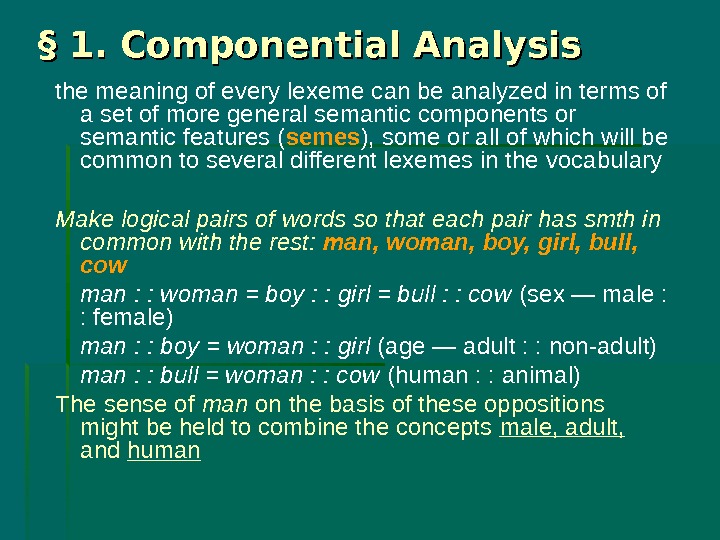


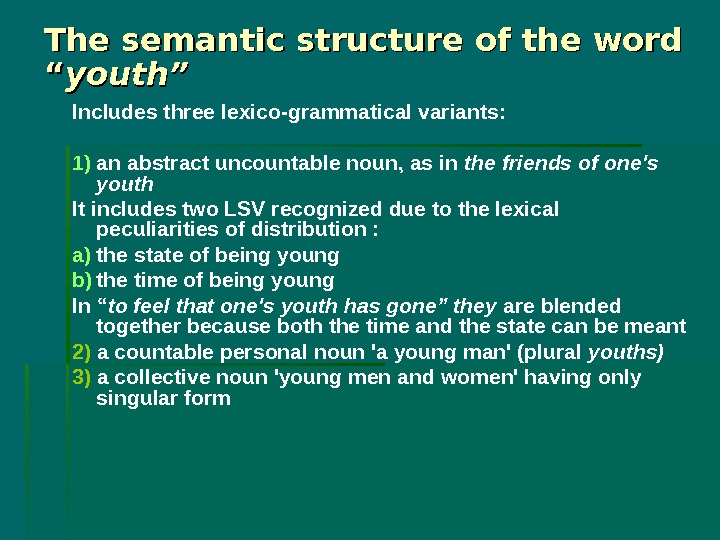



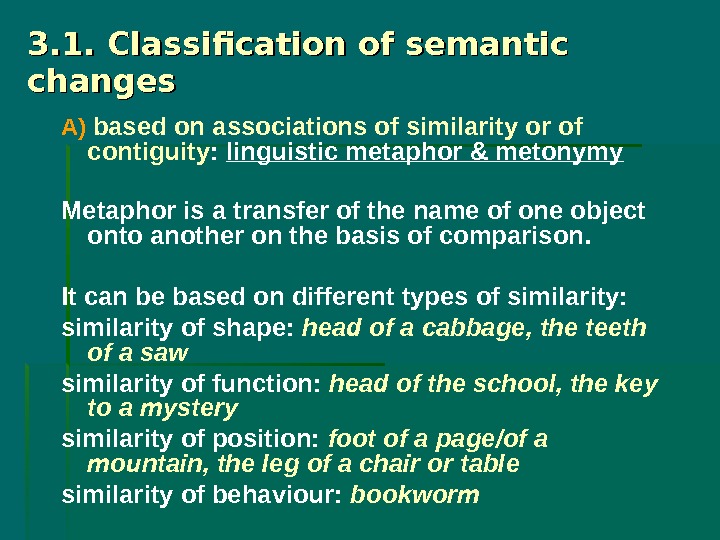

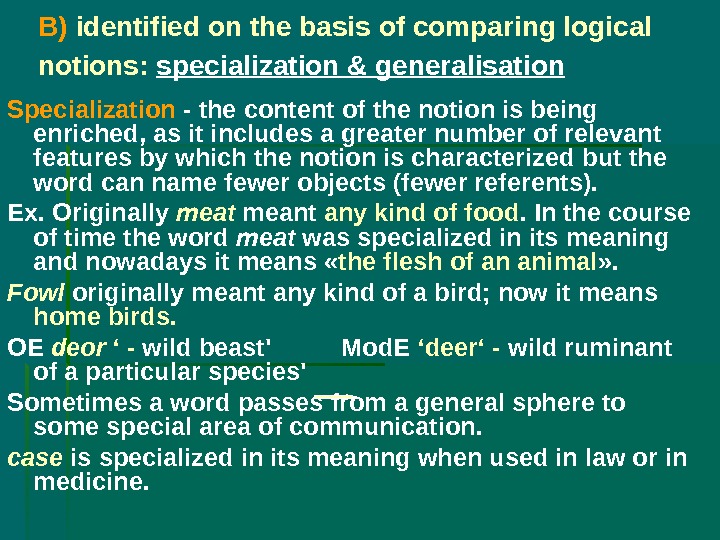




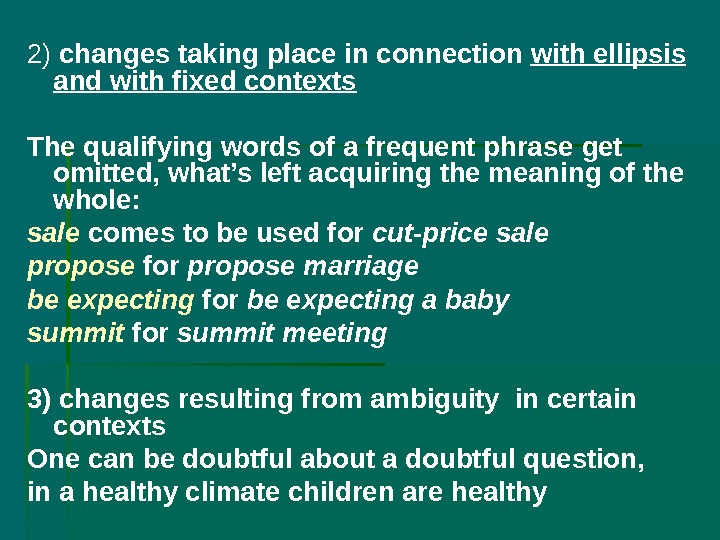


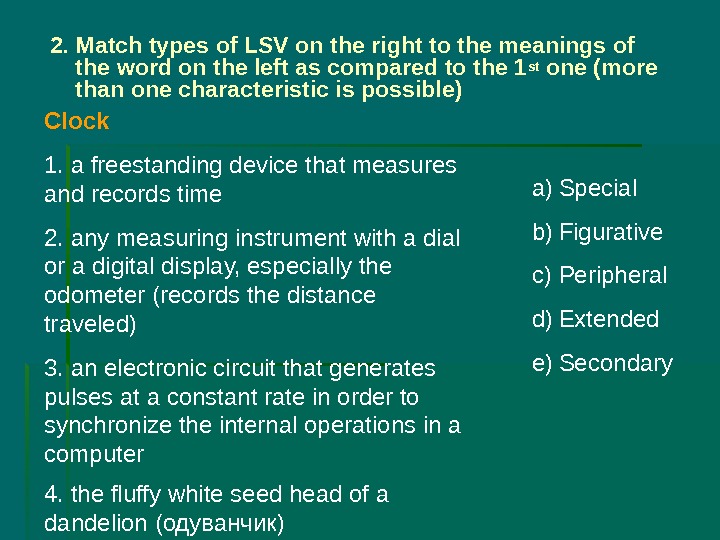


министерство образования российской федерации
Столичный институт переводчиков
факультет английского языка
РЕФЕРАТ
The meaning
of english words
Выполнила:
Научный руководитель:
Москва
2000
content
What Is «Meaning»? 3
Polysemy. Semantic Structure of the Word 3
Types of Semantic Components 6
Meaning and Context 7
What Is «Meaning»?
The linguistic science at present is not able to put forward a definition of meaning which is conclusive. However, there are certain facts of which we can be reasonably sure, and one of them is that the very function of the word as a unit of communication is made possible by its possessing a meaning. Therefore, among the word’s various characteristics, meaning is certainly the most important.
Generally speaking, meaning can be more or less described as a component of the word through which a concept (mental phenomena) is communicated. Meaning endows the word with the ability of denoting real objects, qualities, actions and abstract notions. The relationships between “referent” (object, etc. denoted by the word), “concept” and “word” are traditionally represented by the following triangle:
Thought or Reference
(Concept = mental phenomena)
Symbol Referent
(word) (object denoted by the word)
By the «symbol» here is meant the word; “thought” or “reference” is concept. The dotted line suggests that there is no immediate relation between “word” and “referent”: it is established only through the concept.
On the other hand, there is a hypothesis that concepts can only find their realization through words. It seems that thought is dormant till the word wakens it up. It is only when we hear a spoken word or read a printed word that the corresponding concept springs into mind. The mechanism by which concepts (i. e. mental phenomena) are converted into words (i. e. linguistic phenomena) and the reverse process by which a heard or a printed word is converted into a kind of mental picture are not yet understood or described.
The branch of linguistics which specialises in the study of meaning is called semantics. As with many terms, the term «semantics» is ambiguous for it can stand, as well, for the expressive aspect of language in general and for the meaning of one particular word in all its varied aspects and nuances (i. e. the semantics of a word = the meaning(s) of a word).
Polysemy.
Semantic Structure of the Word
It is generally known that most words convey several concepts and thus possess the corresponding number of meanings. A word having several meanings is called polysemantic, and the ability of words to have more than one meaning is described by the term polysemy.
Polysemy is certainly not an anomaly. Most English words are polysemantic. It should be noted that the wealth of expressive resources of a language largely depends on the degree to which polysemy has developed in the language. Sometimes people who are not very well informed in linguistic matters claim that a language is lacking in words if the need arises for the same word to be applied to several different phenomena. In actual fact, it is exactly the opposite: if each word is found to be capable of conveying at least two concepts instead of one, the expressive potential of the whole vocabulary increases twofold. Hence, a well-developed polysemy is a great advantage in a language.
On the other hand, it should be pointed out that the number of sound combinations that human speech organs can produce is limited. Therefore at a certain stage of language development the production of new words by morphological means is limited as well, and polysemy becomes increasingly important for enriching the vocabulary. From this, it should be clear that the process of enriching the vocabulary does not consist merely in adding new words to it, but, also, in the constant development of polysemy.
The system of meanings of any polysemantic word develops gradually, mostly over the centuries, as more and more new meanings are added to old ones, or oust some of them. So the complicated processes of polysemy development involve both the appearance of new meanings and the loss of old ones. Yet, the general tendency with English vocabulary at the modern stage of its history is to increase the total number of its meanings and in this way to provide for a quantitative and qualitative growth of the language’s expressive resources.
When analysing the semantic structure of a polysemantic word, it is necessary to distinguish between two levels of analysis.
On the first level, the semantic structure of a word is treated as a system of meanings. For example, the semantic structure of the noun “fire” could be roughly presented by this scheme (only the most frequent meanings are given):
I
The above scheme suggests that meaning (I) holds a kind of dominance over the other meanings conveying the concept in the most general way whereas meanings (II)—(V) are associated with special circumstances, aspects and instances of the same phenomenon.
Meaning (I) (generally referred to as the main meaning) presents the centre of the semantic structure of the word holding it together. It is mainly through meaning (I) that meanings (II)—(V) (they are called secondary meanings) can be associated with one another, some of them exclusively through meaning (I) — the main meaning, as, for instance, meanings (IV) and (V).
It would hardly be possible to establish any logical associations between some of the meanings of the noun “bar” except through the main meaning1
:
Bar, n
Meaning’s (II) and (III) have no logical links with one another whereas each separately is easily associated with meaning (I): meaning (II) through the traditional barrier dividing a court-room into two parts; meaning (III) through the counter serving as a kind of barrier between the customers of a pub and the barman.
Yet, it is not in every polysemantic word that such a centre can be found. Some semantic structures are arranged on a different principle. In the following list of meanings of the adjective “dull” one can hardly hope to find a generalized meaning covering and holding together the rest of the semantic structure.
Dull, adj.
- A dull book, a dull film — uninteresting, monotonous, boring.
- A dull student — slow in understanding, stupid.
- Dull weather, a dull day, a dull colour — not clear or bright.
- A dull sound — not loud or distinct.
- A dull knife — not sharp.
- Trade is dull — not active.
- Dull eyes (arch.) — seeing badly.
- Dull ears (arch.) — hearing badly.
There is something that all these seemingly miscellaneous meanings have in common, and that is the implication of deficiency, be it of colour (m. III), wits (m. II), interest (m. I), sharpness (m. V), etc. The implication of insufficient quality, of something lacking, can be clearly distinguished in each separate meaning.
Dull, adj.
- Uninteresting — deficient in interest or excitement.
- … Stupid — deficient in intellect.
- Not bright- deficient in light or colour.
- Not loud — deficient in sound.
- Not sharp — deficient in sharpness.
- Not active — deficient in activity.
- Seeing badly — deficient in eyesight.
- Hearing badly — deficient in hearing.
The transformed scheme of the semantic structure of “dull” clearly shows that the centre holding together the complex semantic structure of this word is not one of the meanings but a certain component that can be easily singled out within each separate meaning.
On the second level of analysis of the semantic structure of a word: each separate meaning is a subject to structural analysis in which it may be represented as sets of semantic components.
The scheme of the semantic structure of “dull” shows that the semantic structure of a word is not a mere system of meanings, for each separate meaning is subject to further subdivision and possesses an inner structure of its own.
Therefore, the semantic structure of a word should be investigated at both these levels: 1) of different meanings, 2) of semantic components within each separate meaning. For a monosemantic word (i. e. a word with one meaning) the first level is naturally excluded.
Types of Semantic Components
The leading semantic component in the semantic structure of a word is usually termed denotative component (also, the term referential component may be used). The denotative component expresses the conceptual content of a word.
The following list presents denotative components of some English adjectives and verbs:
Denotative components
lonely, adj. — alone, without company …
notorious, adj. — widely known
celebrated, adj. — widely known
to glare, v. — to look
to glance, v. — to look
to shiver, v. — to tremble
to shudder, v. — to tremble
It is quite obvious that the definitions given in the right column only partially and incompletely describe the meanings of their corresponding words. They do not give a more or less full picture of the meaning of a word. To do it, it is necessary to include in the scheme of analysis additional semantic components which are termed connotations or connotative components.
Denotative Connotative
components components
The above examples show how by singling out denotative and connotative components one can get a sufficiently clear picture of what the word really means. The schemes presenting the semantic structures of “glare”, “shiver”, “shudder” also show that a meaning can have two or more connotative components.
The given examples do not exhaust all the types of connotations but present only a few: emotive, evaluative connotations, and also connotations of duration and of cause.
Meaning and Context
It’s important that there is sometimes a chance of misunderstanding when a polysemantic word is used in a certain meaning but accepted by a listener or reader in another.
It is common knowledge that context prevents from any misunderstanding of meanings. For instance, the adjective “dull”, if used out of context, would mean different things to different people or nothing at all. It is only in combination with other words that it reveals its actual meaning: “a dull pupil”, “a dull play”, “dull weather”, etc. Sometimes, however, such a minimum context fails to reveal the meaning of the word, and it may be correctly interpreted only through a second-degree context as in the following example: “The man was large, but his wife was even fatter”. The word “fatter” here serves as a kind of indicator pointing that “large” describes a stout man and not a big one.
Current research in semantics is largely based on the assumption that one of the more promising methods of investigating the semantic structure of a word is by studying the word’s linear relationships with other words in typical contexts, i. e. its combinability or collocability.
Scholars have established that the semantics of words which regularly appear in common contexts are correlated and, therefore, one of the words within such a pair can be studied through the other.
They are so intimately correlated that each of them casts, as it were, a kind of permanent reflection on the meaning of its neighbour. If the verb “to compose” is frequently used with the object “music”, so it is natural to expect that certain musical associations linger in the meaning of the verb “to composed”.
Note, also, how closely the negative evaluative connotation of the adjective “notorious” is linked with the negative connotation of the nouns with which it is regularly associated: “a notorious criminal”, “thief”, “gangster», “gambler”, “gossip”, “liar”, “miser”, etc.
All this leads us to the conclusion that context is a good and reliable key to the meaning of the word.
It’s a common error to see a different meaning in every new set of combinations. For instance: “an angry man”, “an angry letter”. Is the adjective “angry” used in the same meaning in both these contexts or in two different meanings? Some people will say «two» and argue that, on the one hand, the combinability is different (“man” —name of person; “letter” — name of object) and, on the other hand, a letter cannot experience anger. True, it cannot; but it can very well convey the anger of the person who wrote it. As to the combinability, the main point is that a word can realize the same meaning in different sets of combinability. For instance, in the pairs “merry children”, “merry laughter”, “merry faces”, “merry songs” the adjective “merry” conveys the same concept of high spirits.
The task of distinguishing between the different meanings of a word and the different variations of combinability is actually a question of singling out the different denotations within the semantic structure of the word.
1) a sad woman,
2) a sad voice,
3) a sad story,
4) a sad scoundrel (= an incorrigible scoundrel)
5) a sad night (= a dark, black night, arch. poet.)
Obviously the first three contexts have the common denotation of sorrow whereas in the fourth and fifth contexts the denotations are different. So, in these five coniexts we can identify three meanings of “sad”.
- Г.Б.Антрушина, О.В.Афанасьева. Лексикология английского языка. — М. Изд. Дрофа. 1999
- F.R.Palmer. Semantics. A new outline. — M. V.Sh. 1982
1 Only a fragment of the semantic structure of “bar” is given to illustrate the point.
Слайд 1Lecture 3
Semantic Structure of the Word and Its Changes
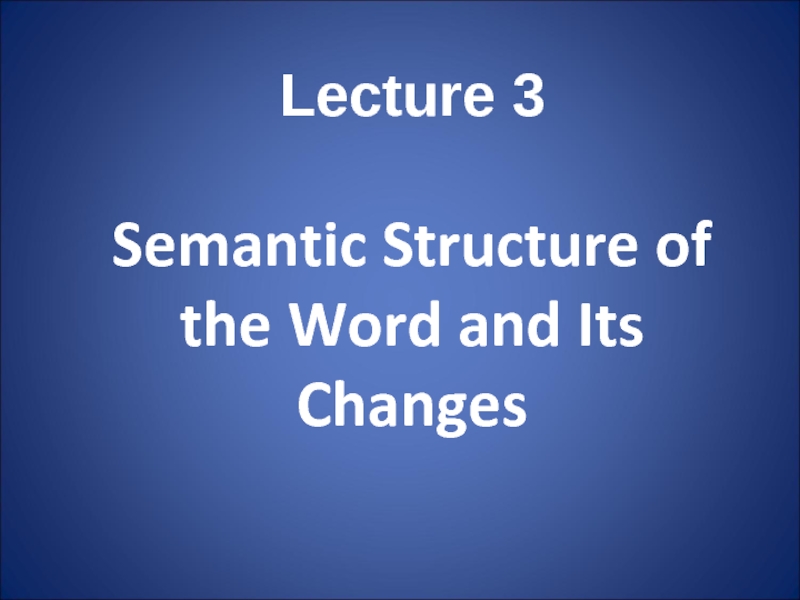
Слайд 2Plan:
Semantics / semasiology. Different approaches to word-meaning.
Types of word-meaning.
Polysemy. Semantic
structure of words. Meaning and context.
Change of word-meaning: the causes, nature and results.
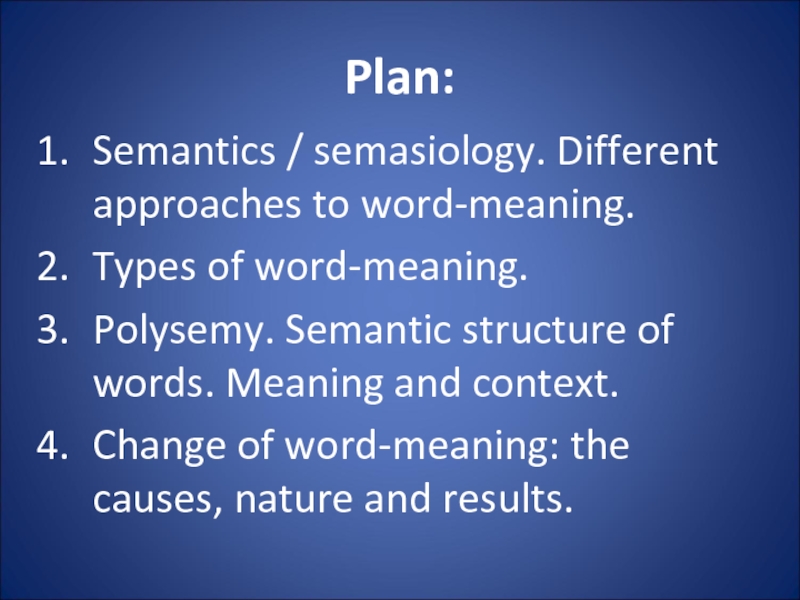
Слайд 3List of Terms:
semantics
referent
referential meaning
grammatical meaning
lexical meaning
denotational meaning
connotational meaning
polysemantic word
polysemy
lexical-semantic variants
basic meaning
peripheral
meaning
primary meaning
secondary meaning
radiation
concatenation
lexical context
grammatical context
thematic context
ellipsis
differentiation of synonyms
linguistic analogy
metaphor
metonymy
restriction of meaning
extension of meaning
ameliorative development of meaning
pejorative development of meaning
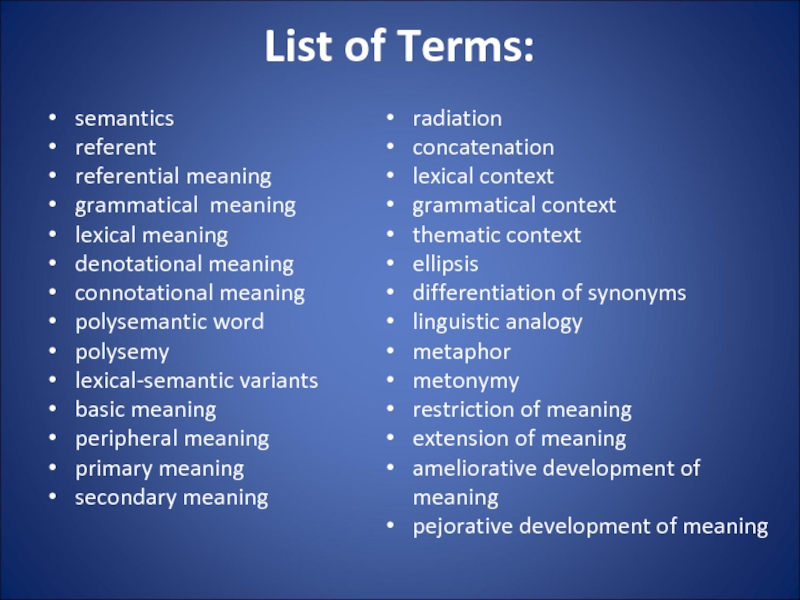
Слайд 4
It is meaning that makes language useful.
George A. Miller,
The science of word, 1991
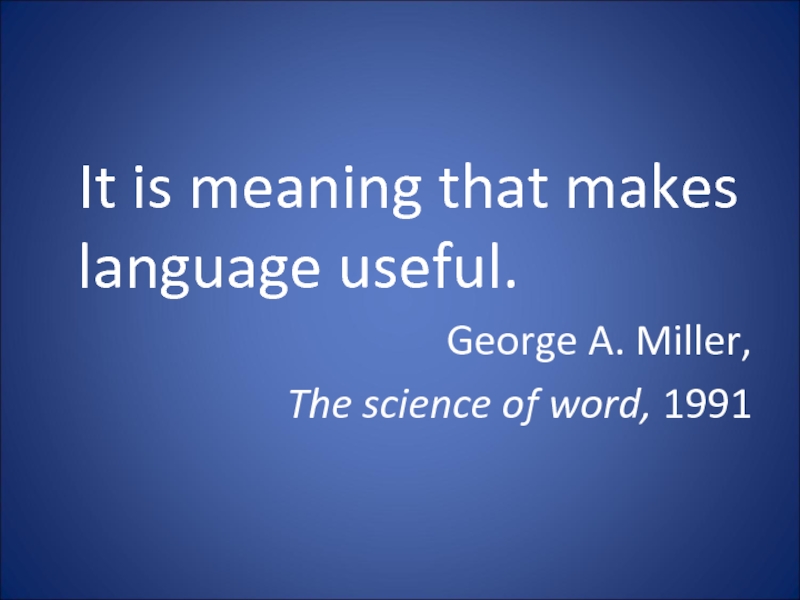
Слайд 5
1. Semantics / semasiology. Different approaches to word-meaning
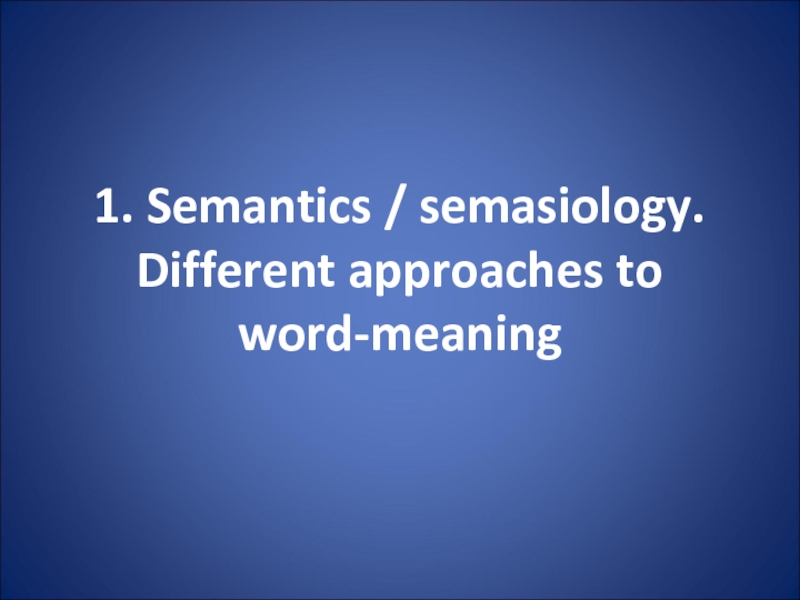
Слайд 6
The function of the word as a unit of
communication is possible by its possessing a meaning.
Among the word’s various characteristics meaning is the most important.
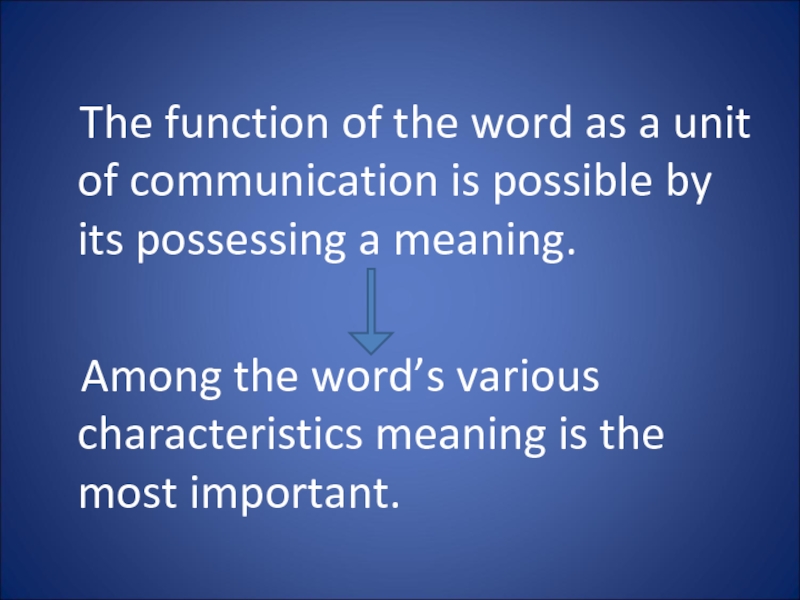
Слайд 7
«The Meaning of Meaning» (1923) by C.K. Ogden and I.A. Richards
– about 20 definitions of meaning
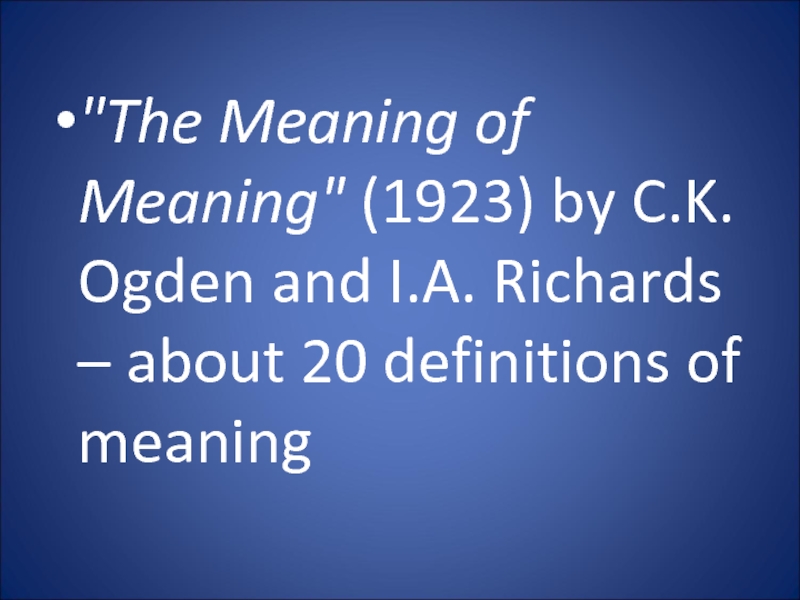
Слайд 8Meaning of a linguistic unit, or linguistic meaning, is studied by
semantics
(from Greek – semanticos ‘significant’)
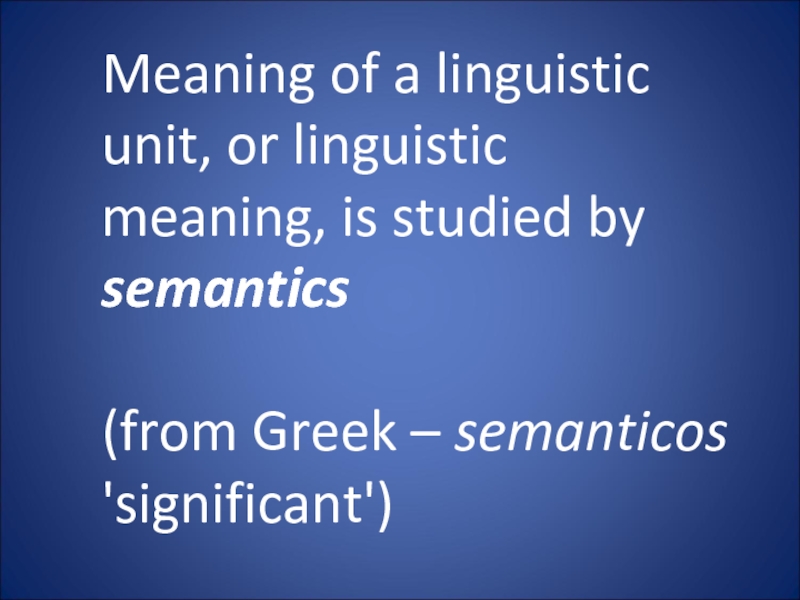
Слайд 9
This linguistic study was pointed out in 1897 by
M. Breal

Слайд 10
Semasiology is a synonym for ‘semantics’
(from
Gk. semasia ‘meaning’ + logos ‘learning’)
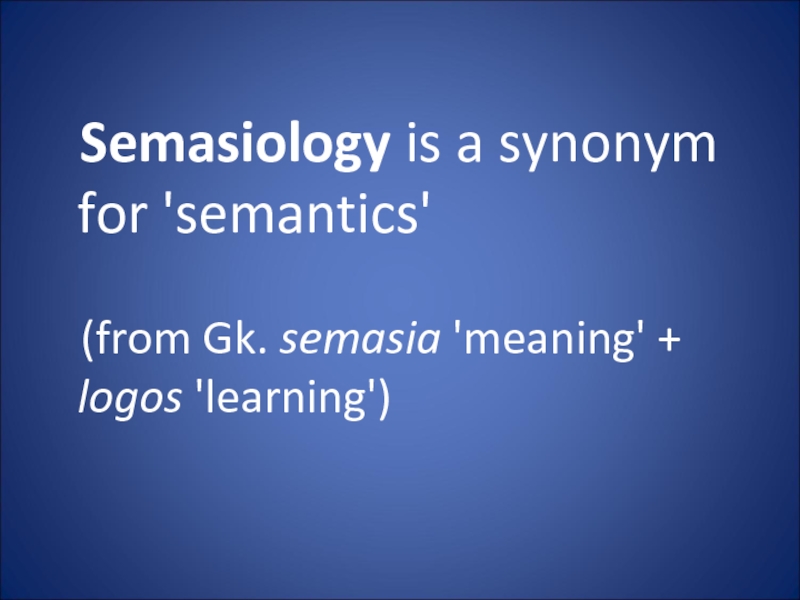
Слайд 11Different Approaches to Word Meaning:
ideational (or conceptual)
referential
functional
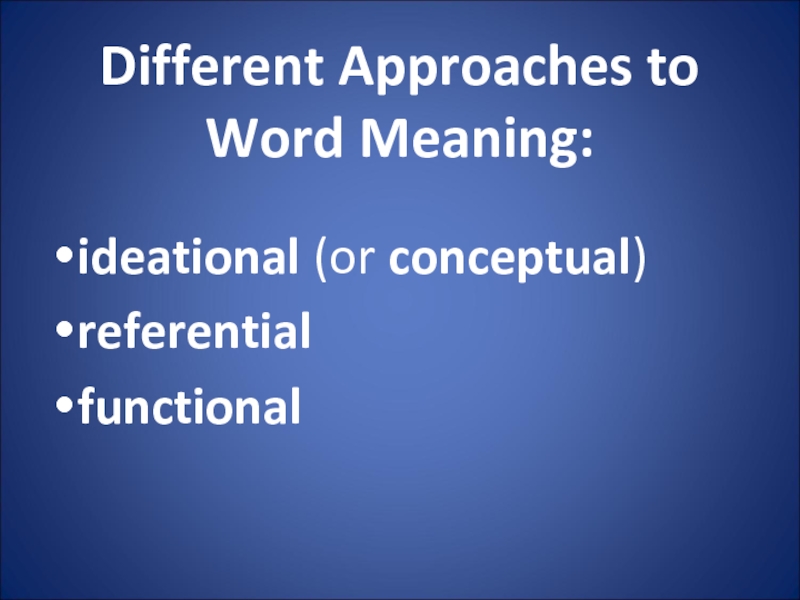
Слайд 12
The ideational theory can be considered the earliest theory
of meaning.
It states that meaning originates in the mind in the form of ideas, and words are just symbols of them.

Слайд 13A difficulty:
not clear why communication and understanding are possible if
linguistic expressions stand for individual personal ideas.

Слайд 14Meaning:
a concept with specific structure.
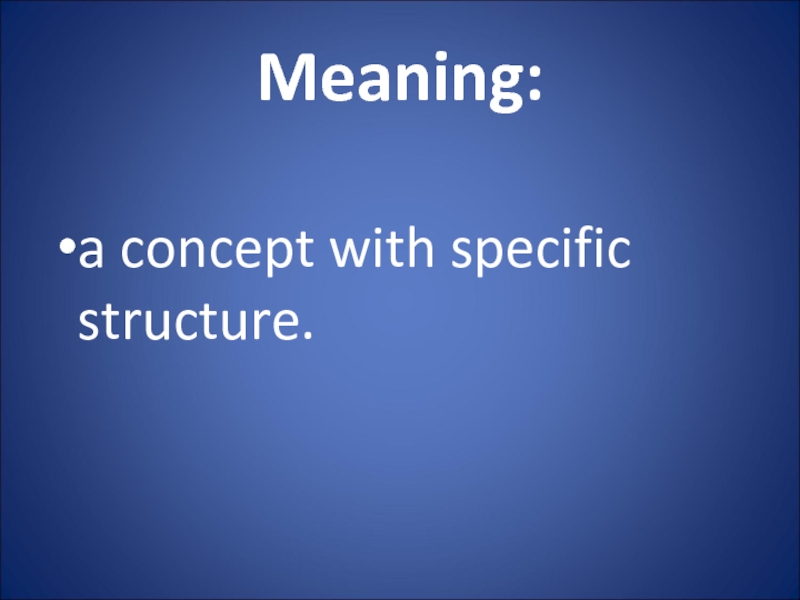
Слайд 15
Do people speaking different languages have different conceptual systems?
If people
speaking different languages have the same conceptual systems why are identical concepts expressed by correlative words having different lexical meanings?
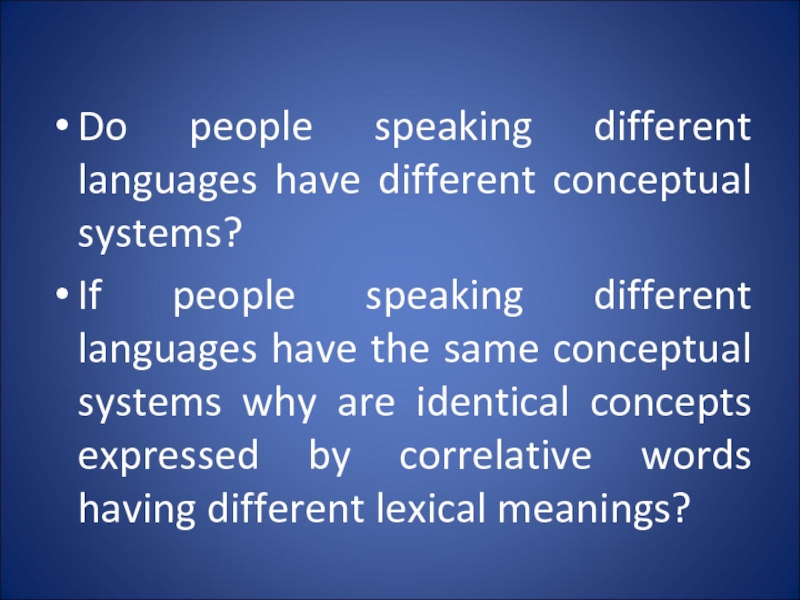
Слайд 16
finger ‘one of 10 movable parts of joints at the end
of each human hand, or one of 8 such parts as opposed to the thumbs‘
and
палец ‘подвижная конечная часть кисти руки, стопы ноги или лапы животного’
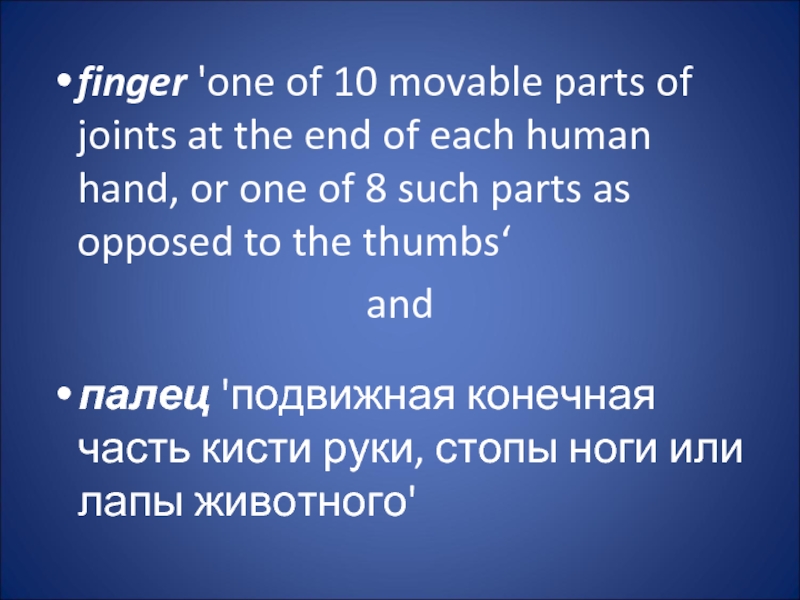
Слайд 17
Referential theory is based on interdependence of things,
their concepts and names.
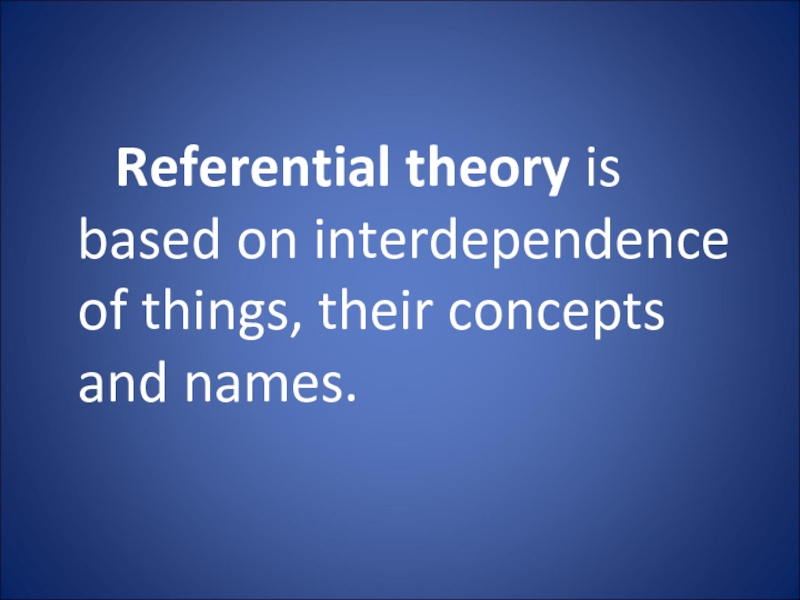
Слайд 18
The complex relationships between referent (object denoted by the
word), concept and word are traditionally represented by the following triangle:
Thought = concept
Symbol = word Referent = object
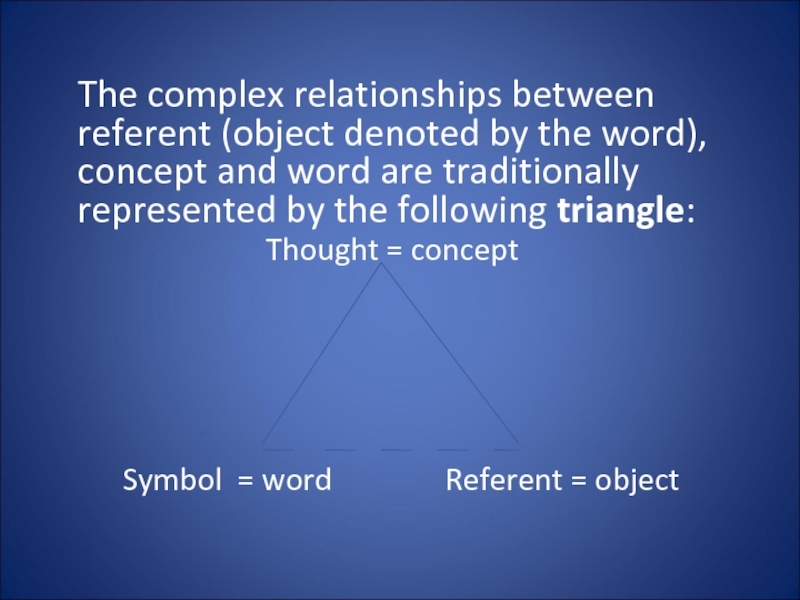
Слайд 19
an animal, with 4
legs and a tail, can bark and
bite
dog
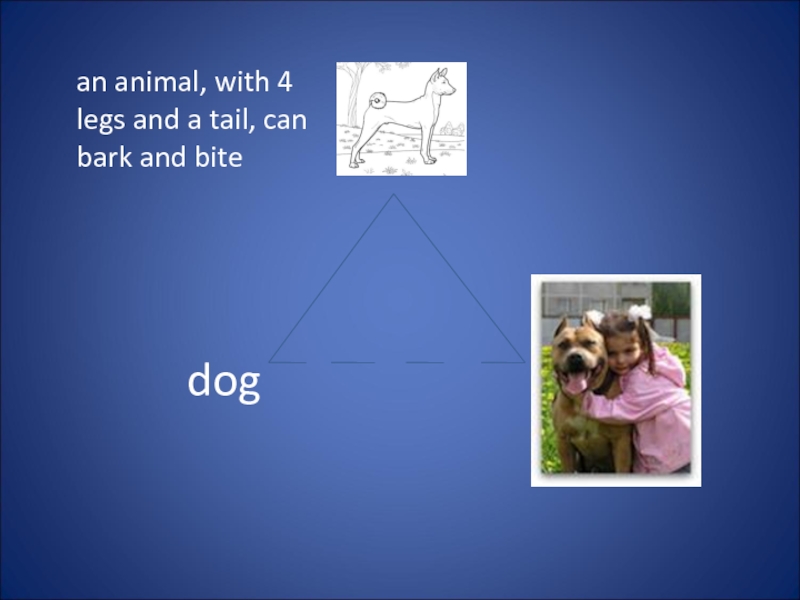
Слайд 20Meaning concept
different words having different meanings may be
used to express the same concept
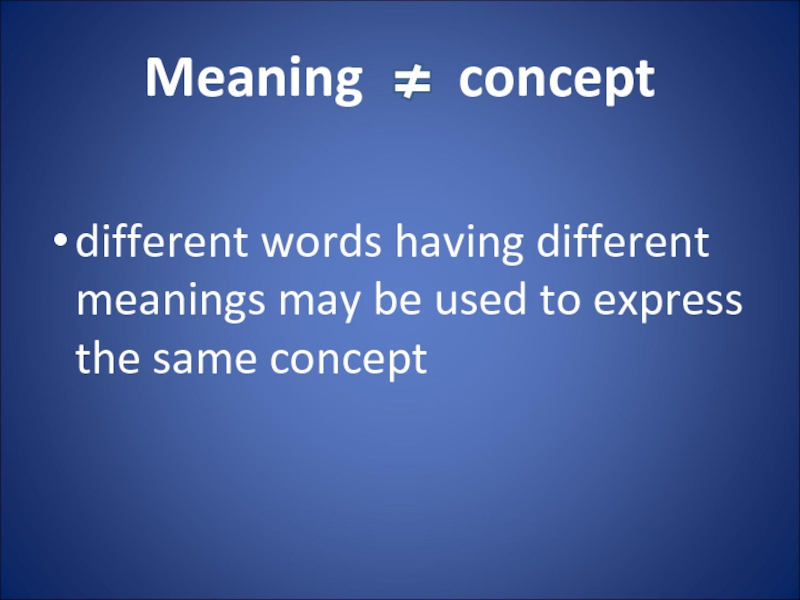
Слайд 21Concept of dying
die
pass away
kick the bucket
join the majority,
etc

Слайд 22Meaning symbol
In different languages:
a word with the same
meaning have different sound forms (dog, собака)
words with the same sound forms have different meaning (лук, look)
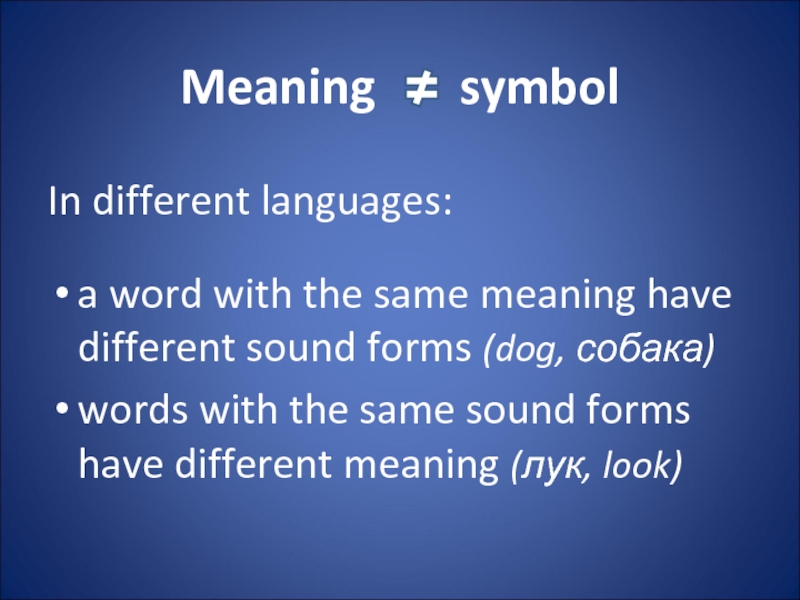
Слайд 23Meaning referent
to denote one and the same object
we can give it different names
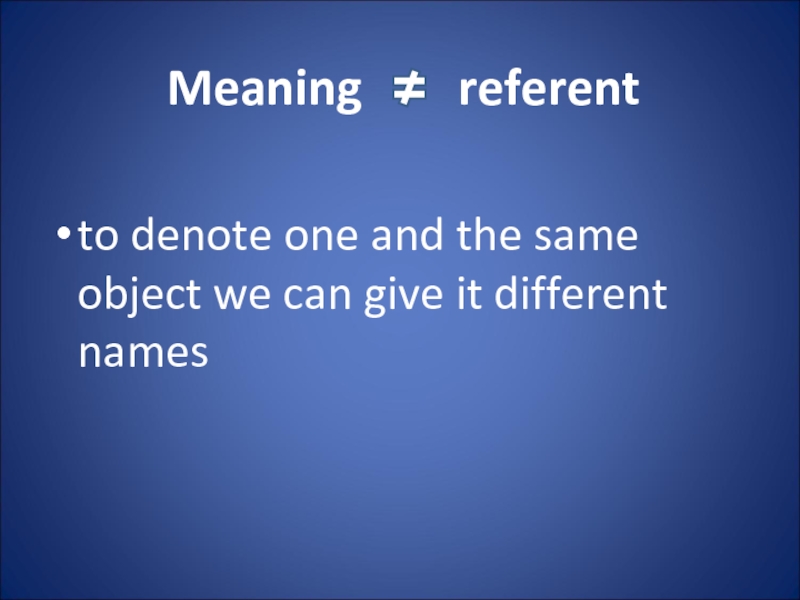
Слайд 24A horse
in various contexts:
horse,
animal,
creature,
it, etc.
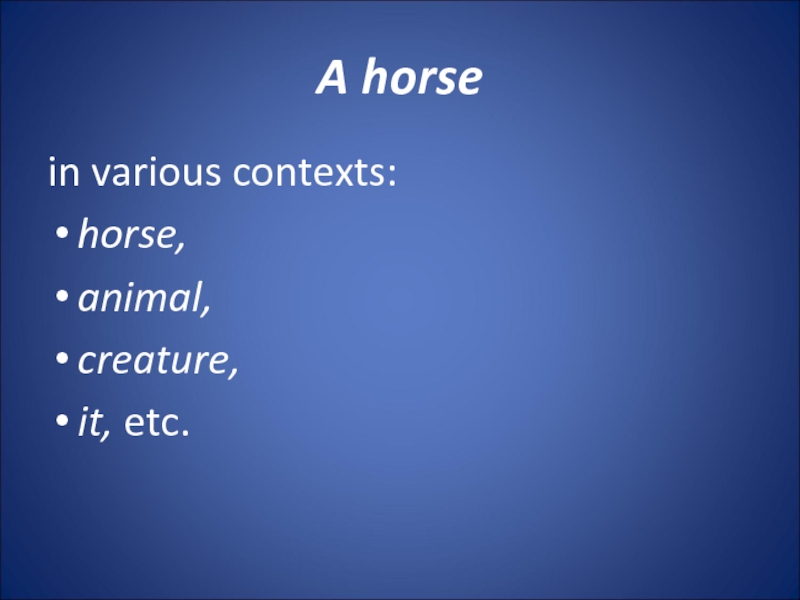
Слайд 25Word meaning:
the interrelation of all three components of
the semantic triangle: symbol, concept and referent, though meaning is not equivalent to any of them.
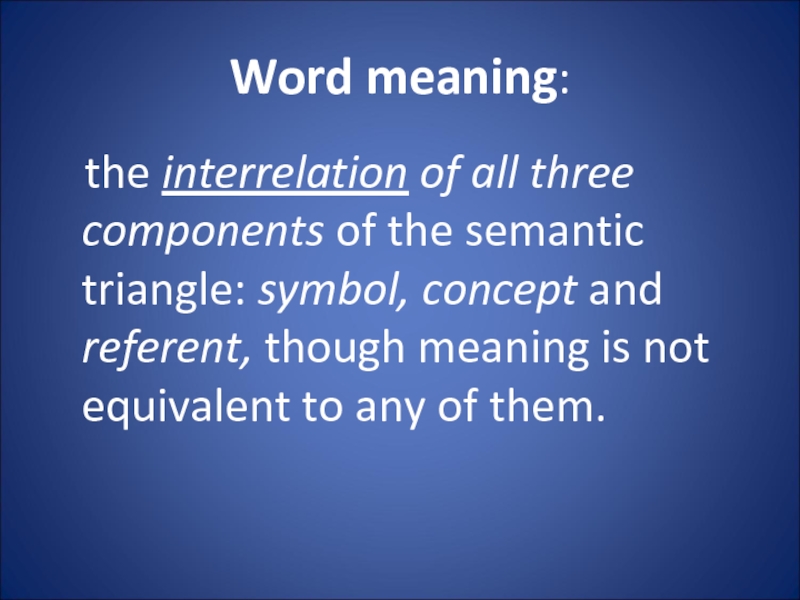
Слайд 26
Functionalists study word meaning by analysis of the way
the word is used in certain contexts.
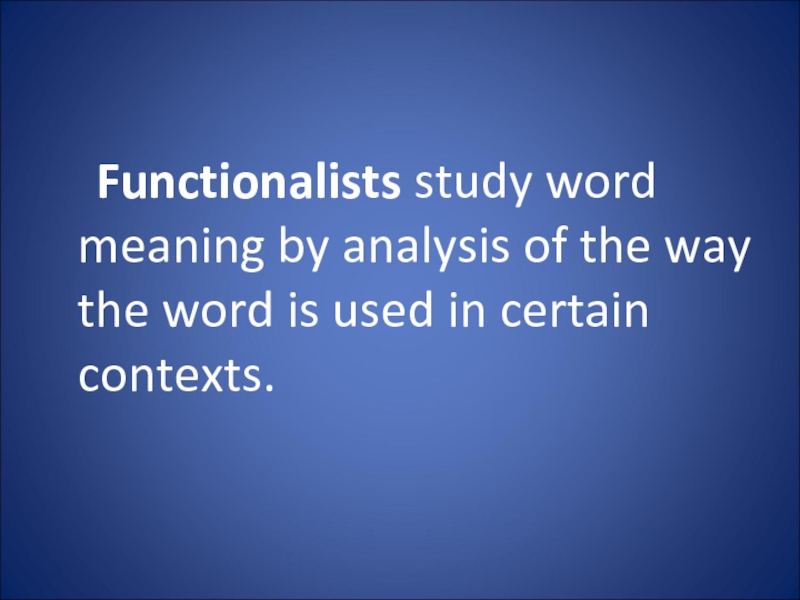
Слайд 27
The meaning of a word is its use
in language.
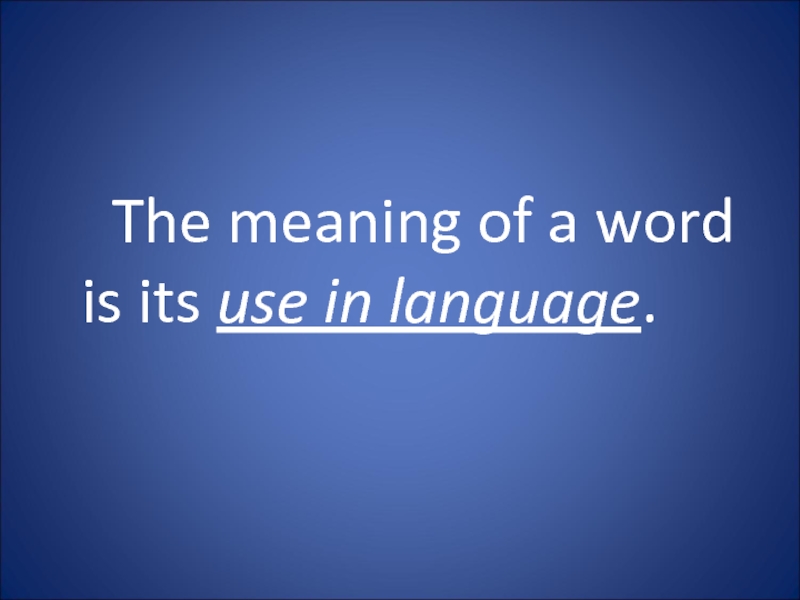
Слайд 28cloud and cloudy
have different meanings because in speech they function
differently and occupy different positions in relation to other words.
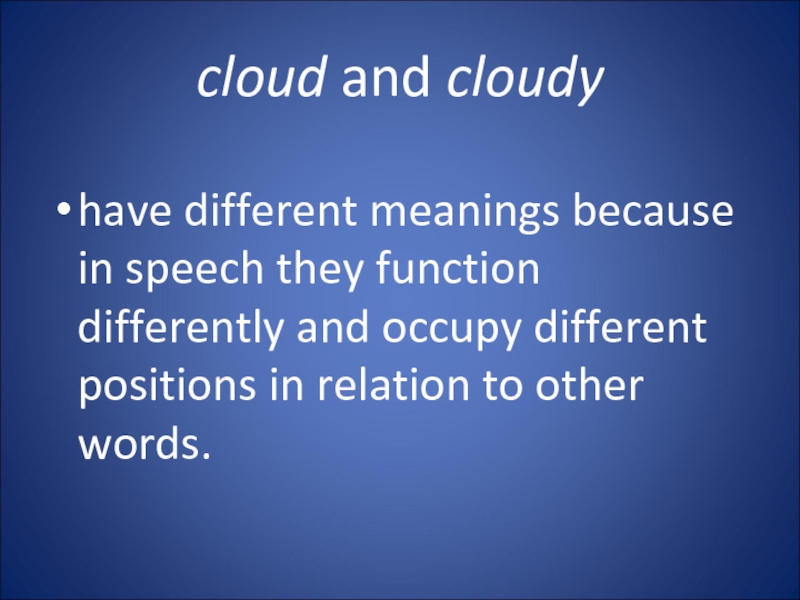
Слайд 29Meaning:
a component of the word through which a concept
is communicated
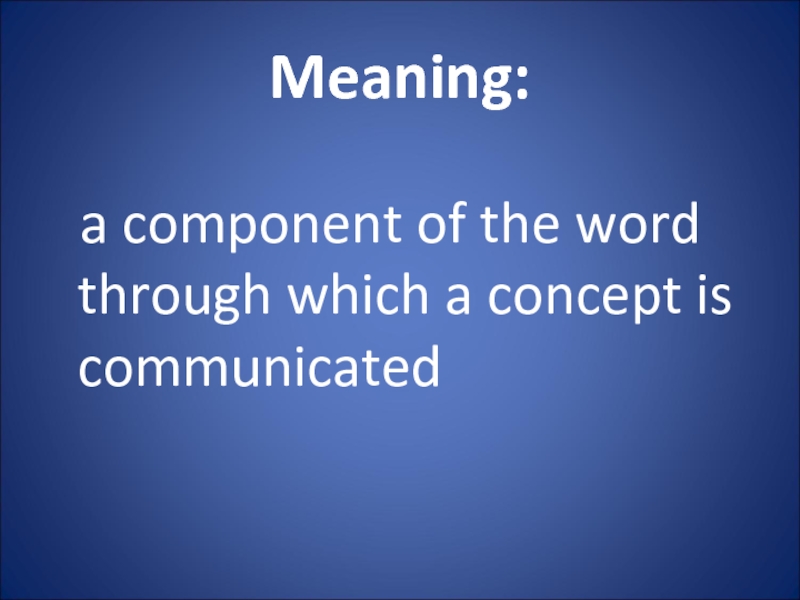
Слайд 31According to the conception of word meaning as a specific structure:
functional
meaning: part of speech meaning (nouns usually denote «thingness», adjectives – qualities and states)
grammatical: found in identical sets of individual forms of different words (she goes/works/reads, etc.)
lexical: the component of meaning proper to the word as a linguistic unit highly individual and recurs in all the forms of a word (the meaning of the verb to work ‘to engage in physical or mental activity’ that is expressed in all its forms: works, work, worked, working, will work)
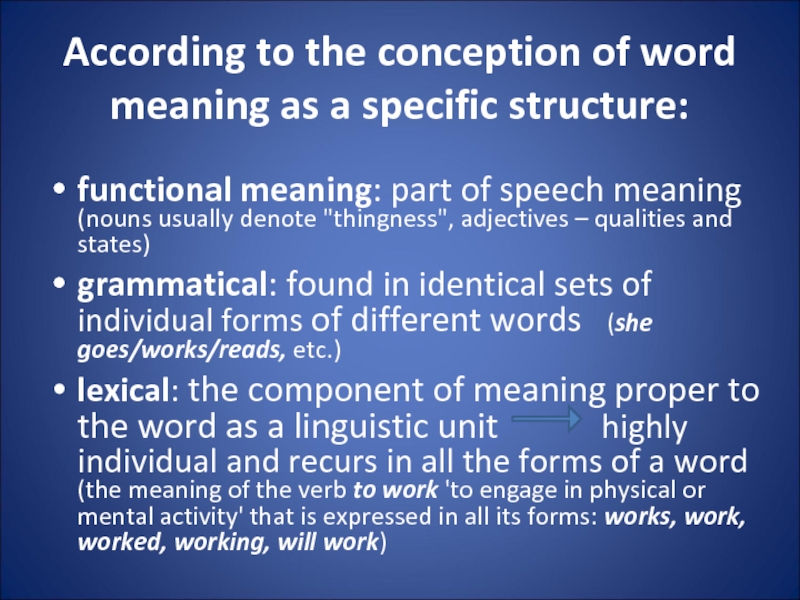
Слайд 32Lexical Meaning:
denotational
connotational
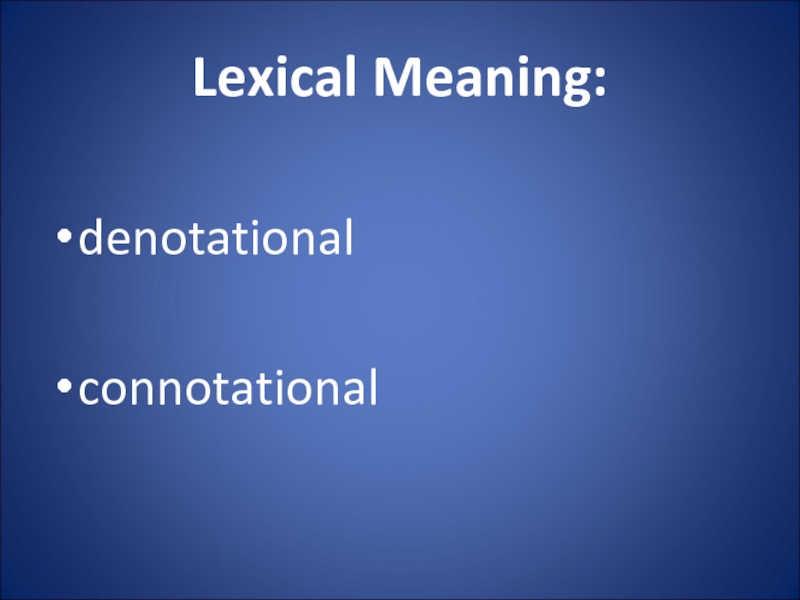
Слайд 33
Denotational lexical meaning provides correct reference of a word to an
individual object or a concept.
It makes communication possible and is explicitly revealed in the dictionary definition (chair ‘a seat for one person typically having four legs and a back’).

Слайд 35
Connotational lexical meaning is an emotional colouring of the
word. Unlike denotational meaning, connotations are optional.
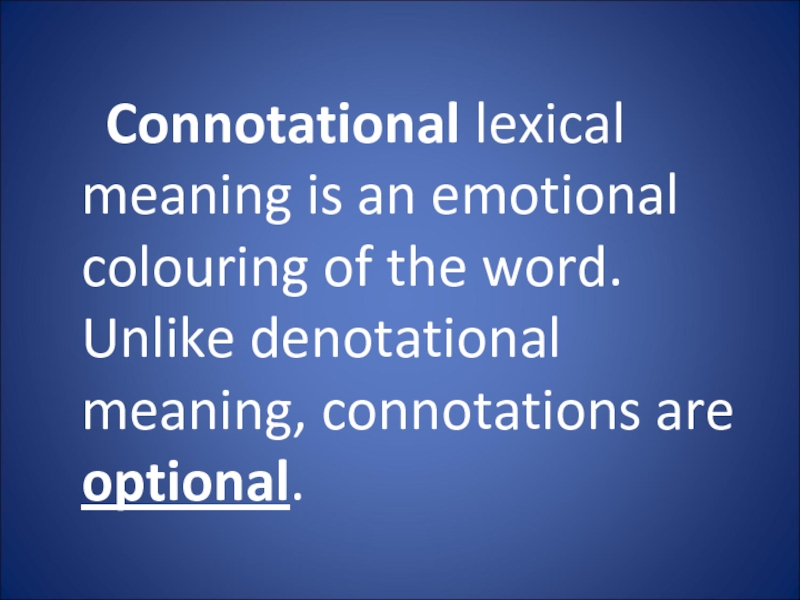
Слайд 36Connotations:
Emotive charge may be inherent in word meaning (like in attractive,
repulsive) or may be created by prefixes and suffixes (like in piggy, useful, useless).
It’s always objective because it doesn’t depend on a person’s perception.
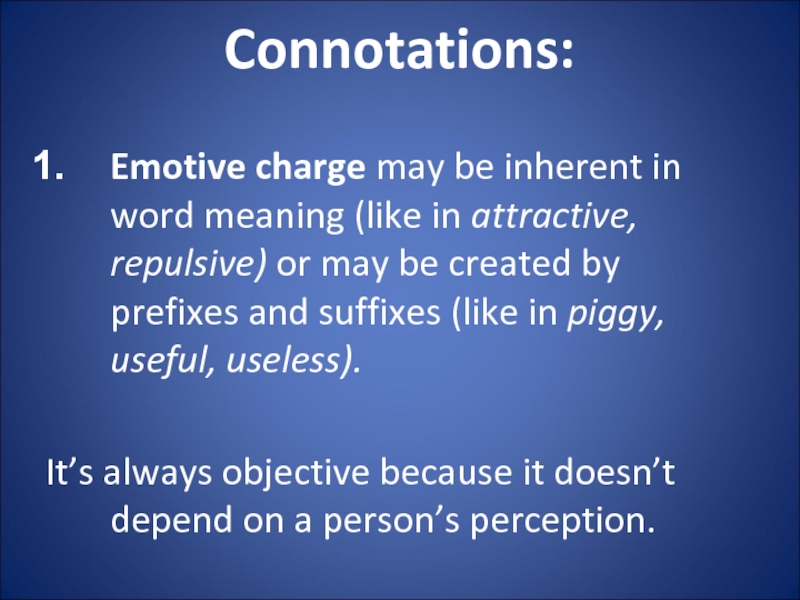
Слайд 37
2. Stylistic reference refers the word to a certain style:
neutral words
colloquial
bookish,
or literary words
Eg. father – dad – parent .
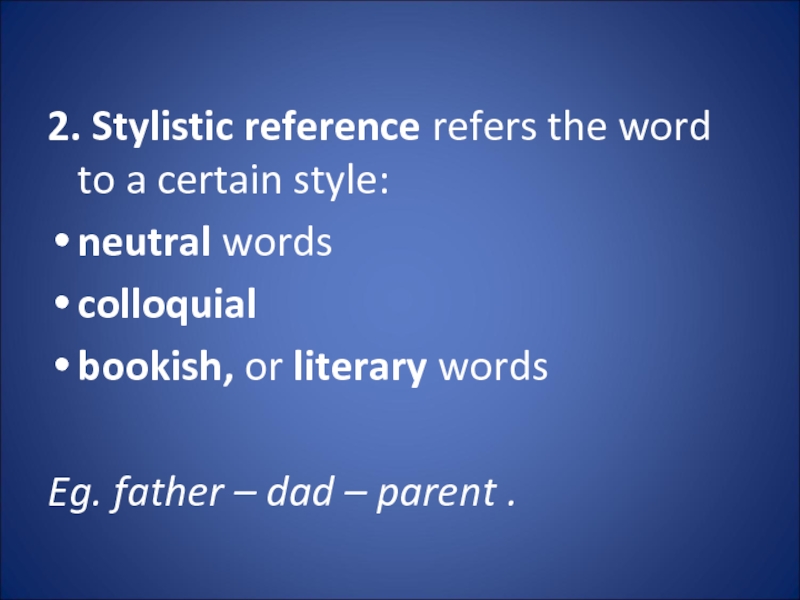
Слайд 38
3. Evaluative connotations express approval or disapproval (charming, disgusting).
4. Intensifying connotations
are expressive and emphatic (magnificent, gorgeous)

Слайд 39
Denotative component
Lonely = alone, without company
To glare = to look
Connotative component
+ melancholy, sad (emotive con.)
+ 1) steadily, lastingly (con. of duration)
+ 2) in anger, rage (emotive con.)
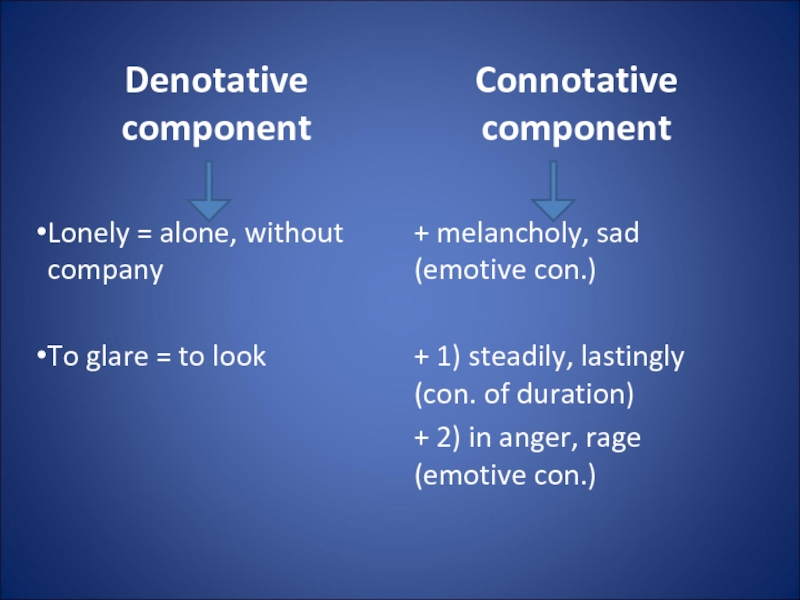
Слайд 40
3. Polysemy. Semantic structure of words. Meaning and context
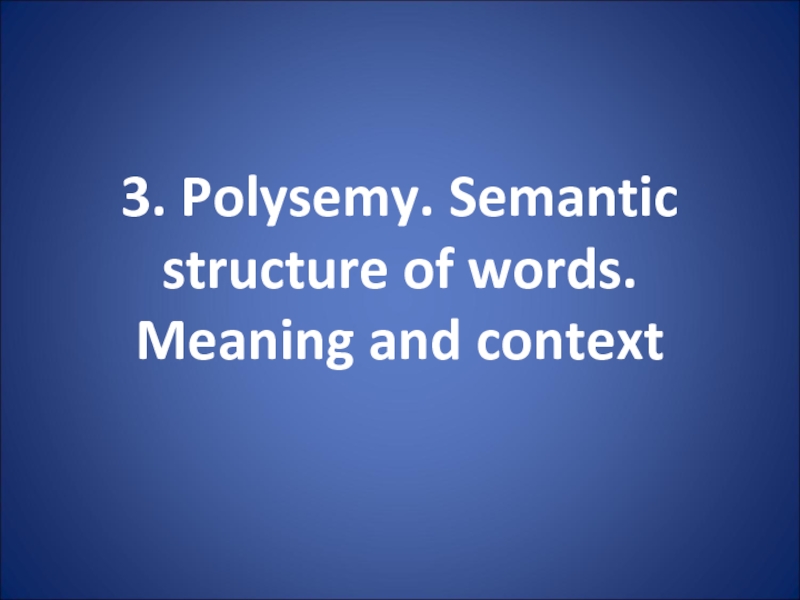
Слайд 41
A polysemantic word is a word having more than one meaning.
Polysemy
is the ability of words to have more than one meaning.
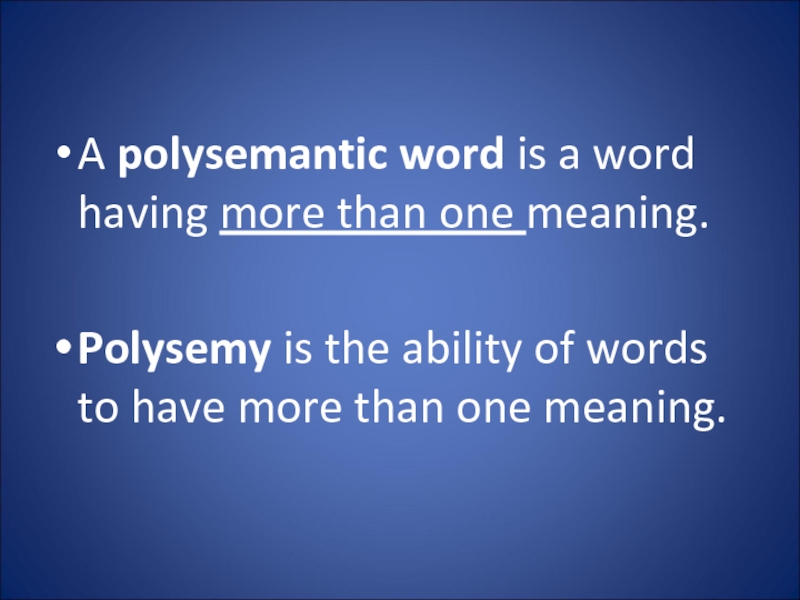
Слайд 42
Most English words are polysemantic.
A well-developed polysemy is a great advantage in a language.
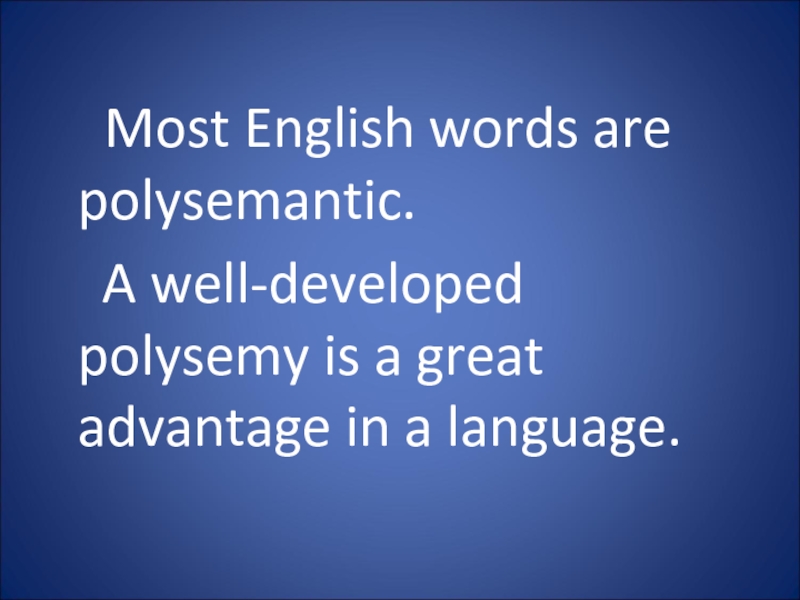
Слайд 43Monosemantic Words:
terms (synonym, bronchitis, molecule),
pronouns (this, my, both),
numerals, etc.
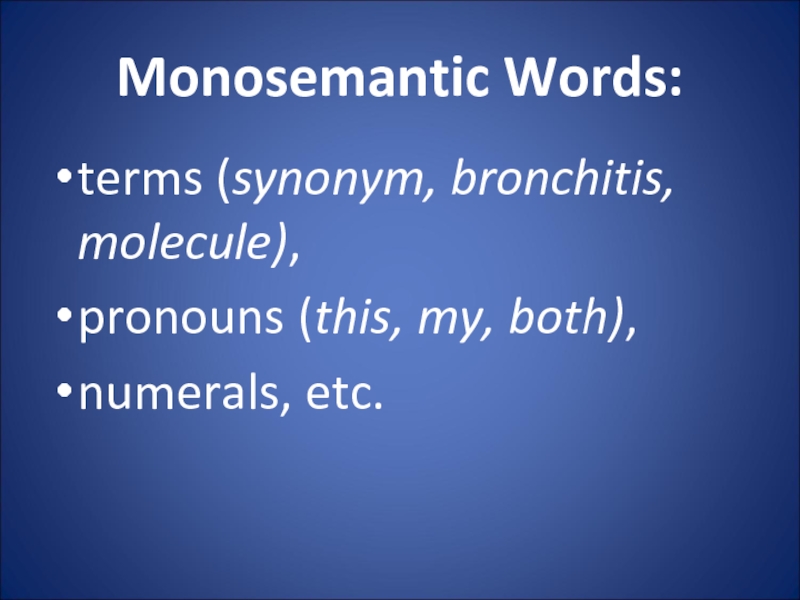
Слайд 44The main causes of polysemy:
a large number of:
1) monosyllabic words;
2) words of long duration (that existed for centuries).
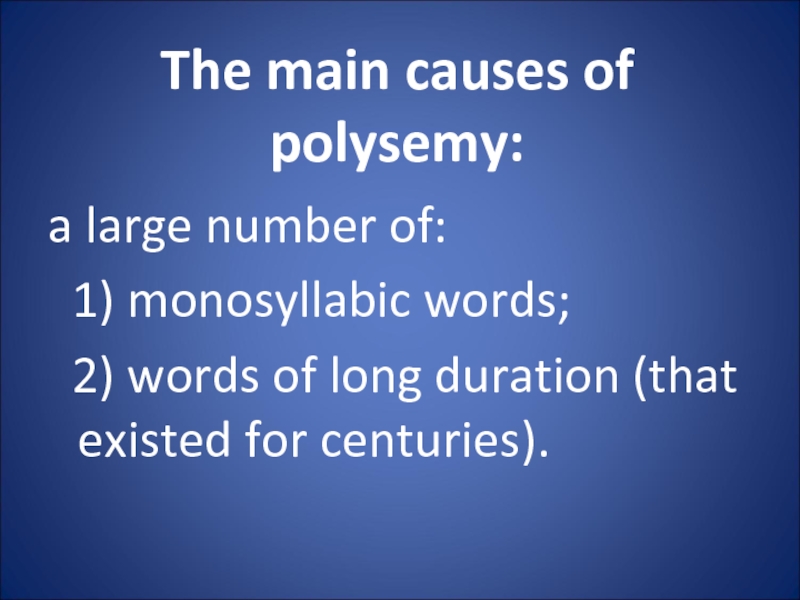
Слайд 45The sources of polysemy:
1) the process of meaning change (meaning specialization:
is used in more concrete spheres);
2) figurative language (metaphor and metonymy);
3) homonymy;
4) borrowing of meanings from other languages.
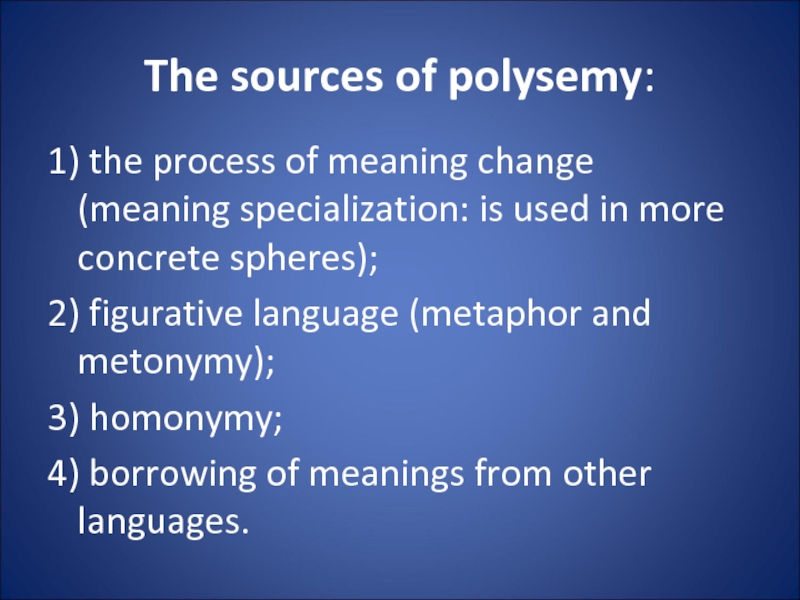
Слайд 46blanket
a woolen covering used on beds,
a covering for keeping a house
warm,
a covering of any kind (a blanket of snow),
covering in most cases (used attributively), e.g. we can say: a blanket insurance policy.
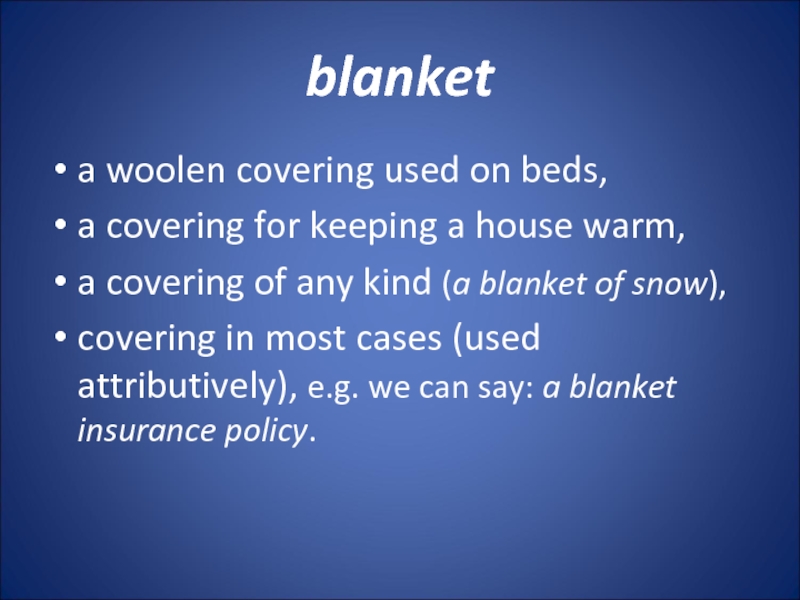
Слайд 47
Meanings of a polysemantic word are organized in a
semantic structure
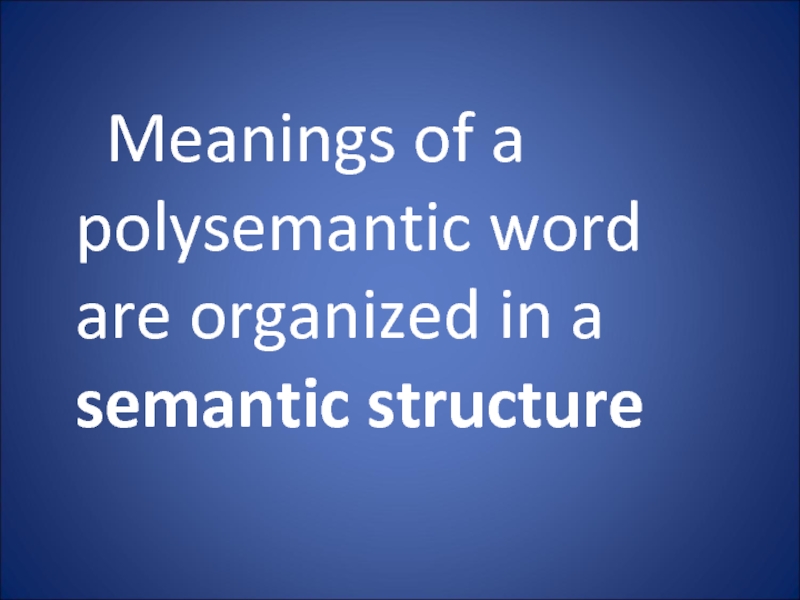
Слайд 48Lexical-semantic variant
one of the meanings of a polysemantic word used
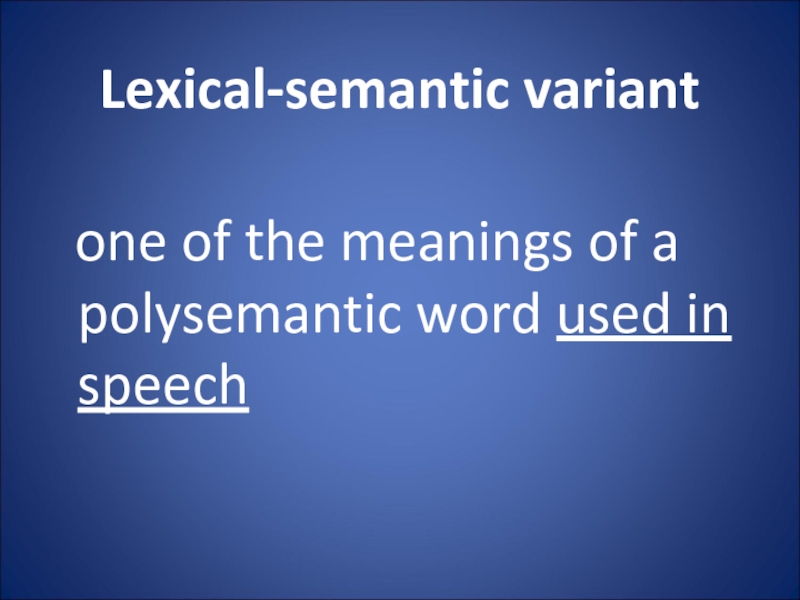
Слайд 49A Word’s Semantic Structure Is Studied:
Diachronically (in the process of its
historical development): the historical development and change of meaning becomes central. Focus: the process of acquiring new meanings.
Synchronically (at a certain period of time): a co-existence of different meanings in the semantic structure of the word at a certain period of language development. Focus: value of each individual meaning and frequency of its occurrence.
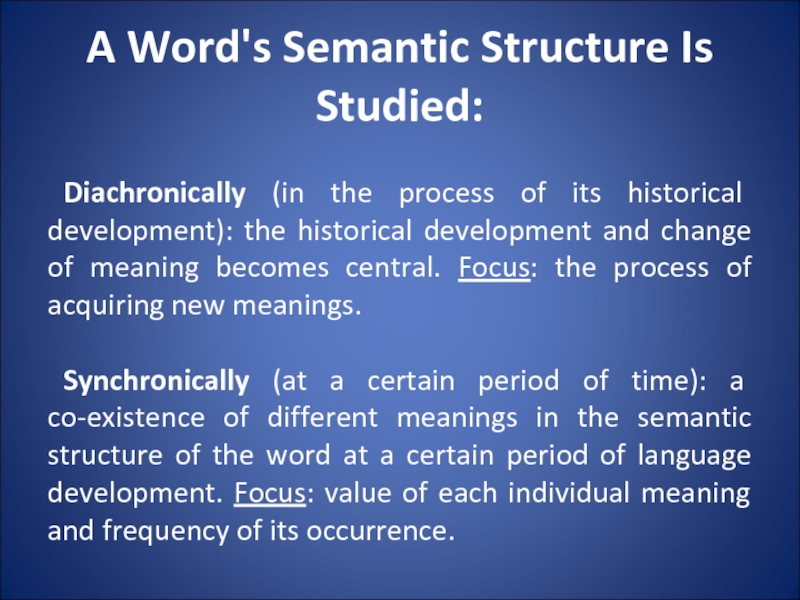
Слайд 50
The meaning first registered in the language is called primary.
Other
meanings are secondary, or derived, and are placed after the primary one.
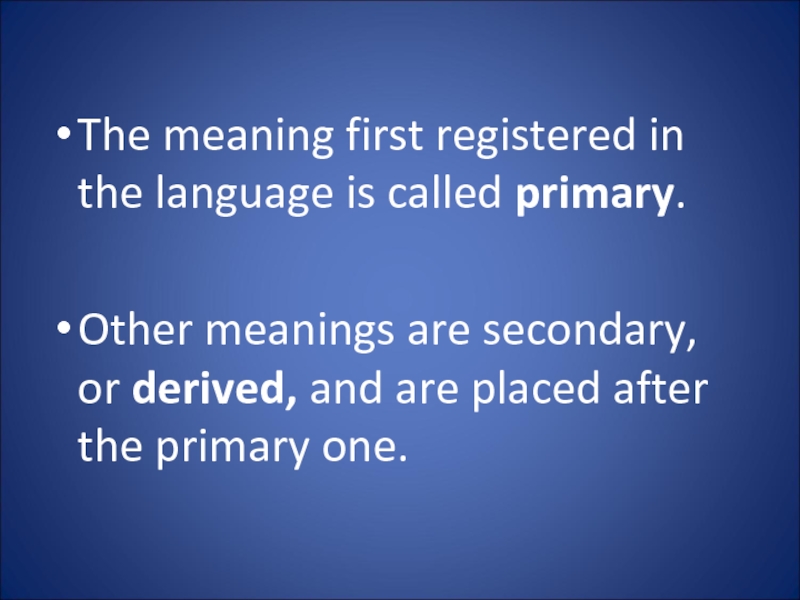
Слайд 51table
a piece of furniture (primary meaning)
the persons
seated at the table
the food put on the table, meals
a thin flat piece of stone, metal, wood
slabs of stone
words cut into them or written on them
an orderly arrangement of facts
part of a machine-tool on which the work is put to be operated on
a level area, a plateau
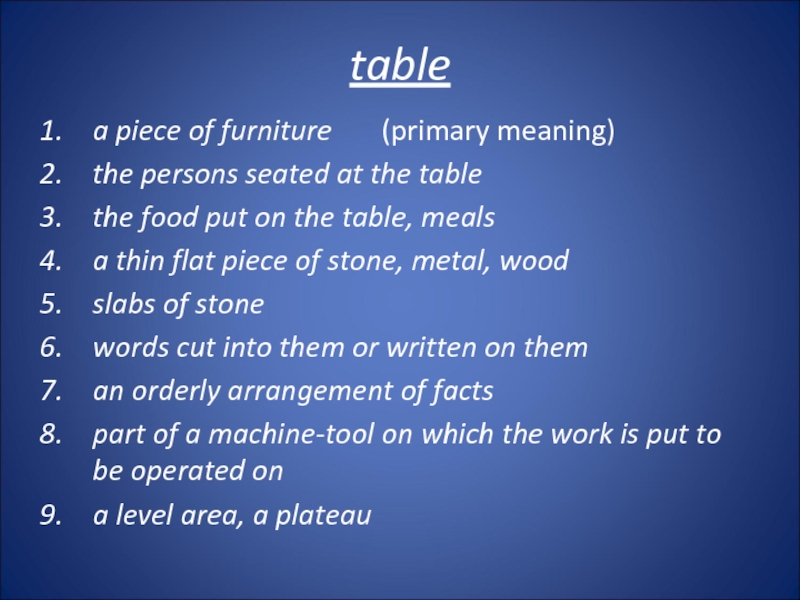
Слайд 52
The meaning that first occurs to our mind, or is understood
without a special context is called the basic or main meaning.
Other meanings are called peripheral or minor.
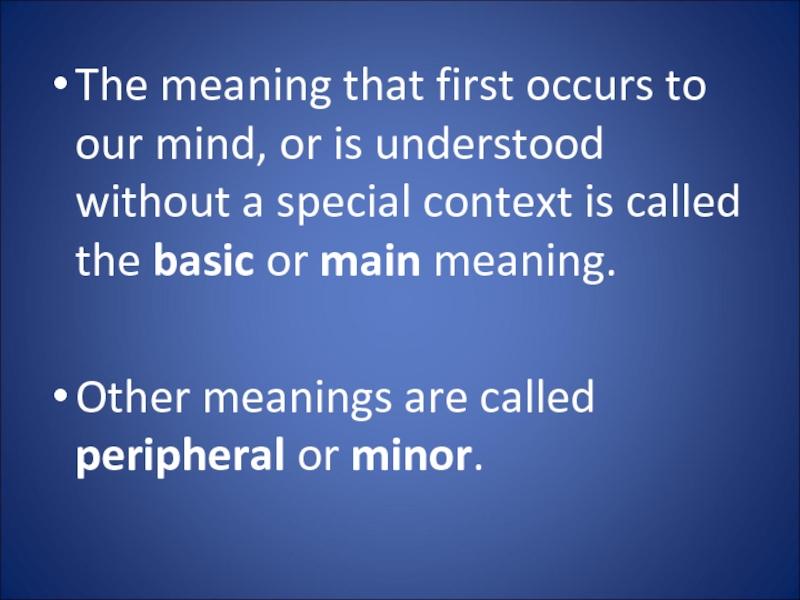
Слайд 53Fire
1. flame (main meaning)
2. an instance of destructive burning
e.g. a forest fire
4. the shooting of guns
e.g. to open fire
3. burning material in a stone, fireplace
e.g. a camp fire
5. strong feeling, passion
e.g. speech lacking fire

Слайд 54Processes of the Semantic Development of a Word:
radiation (the primary meaning
stands in the center and the secondary meanings proceed out of it like rays. Each secondary meaning can be traced to the primary meaning)
concatenation (secondary meanings of a word develop like a chain. It is difficult to trace some meanings to the primary one)
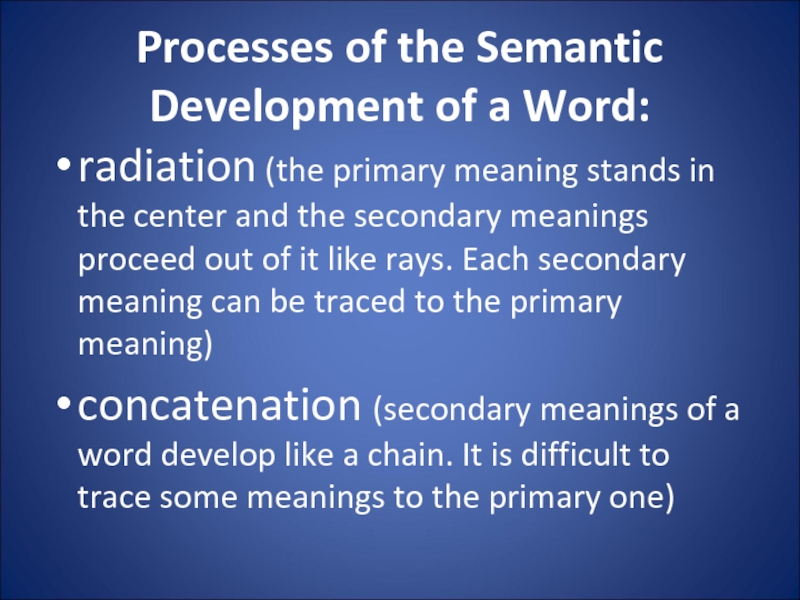
Слайд 55crust
hard outer part of bread
hard part of anything (a
pie, a cake)
harder layer over soft snow
a sullen gloomy person
Impudence
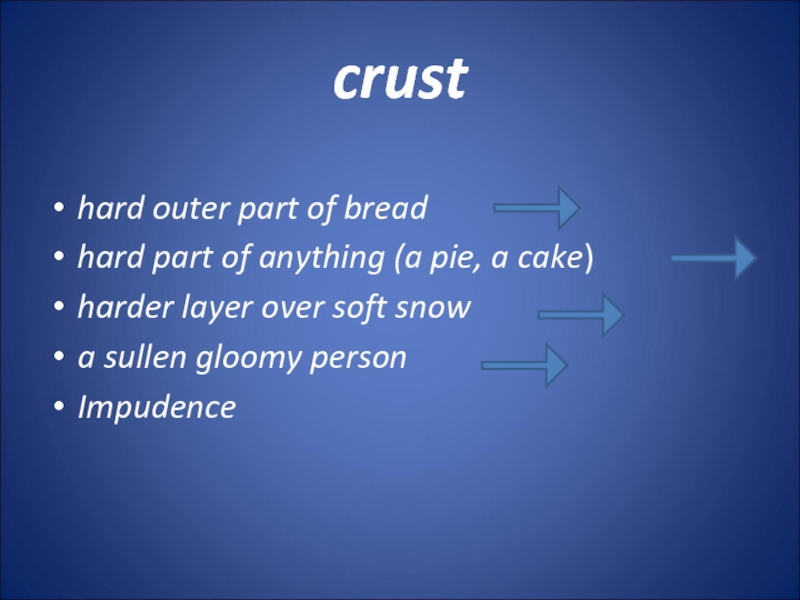
Слайд 56
Polysemy exists not in speech but in the language.
It’s
easy to identify the main meaning of a separate word. Other meanings are revealed in context.
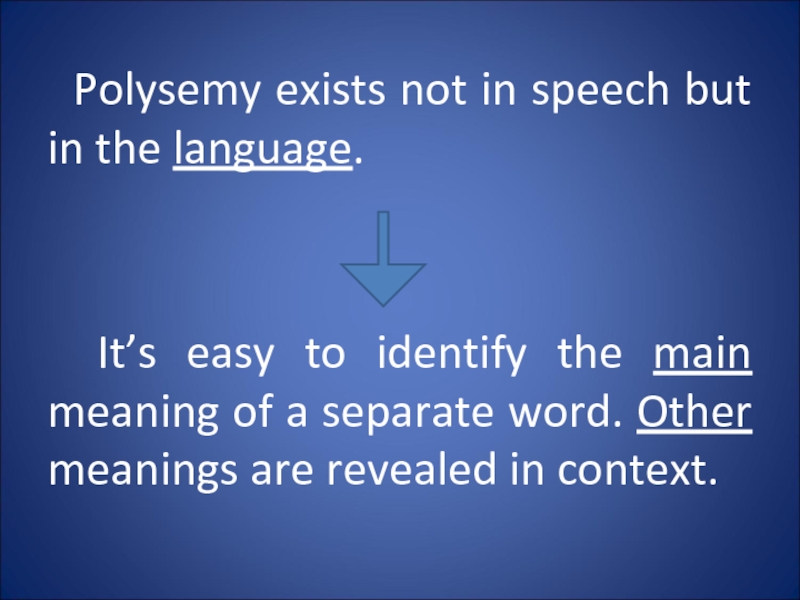
Слайд 57Context:
linguistic
1. lexical – a number of lexical units
around the word which enter into interaction with it (i.e. words combined with a polysemantic word are important).
2. grammatical – a number of lexical units around the world viewed on the level of parts of speech.
3. thematic – a very broad context, sometimes a text or even a book.
extralinguistic – different cultural, social, historical factors
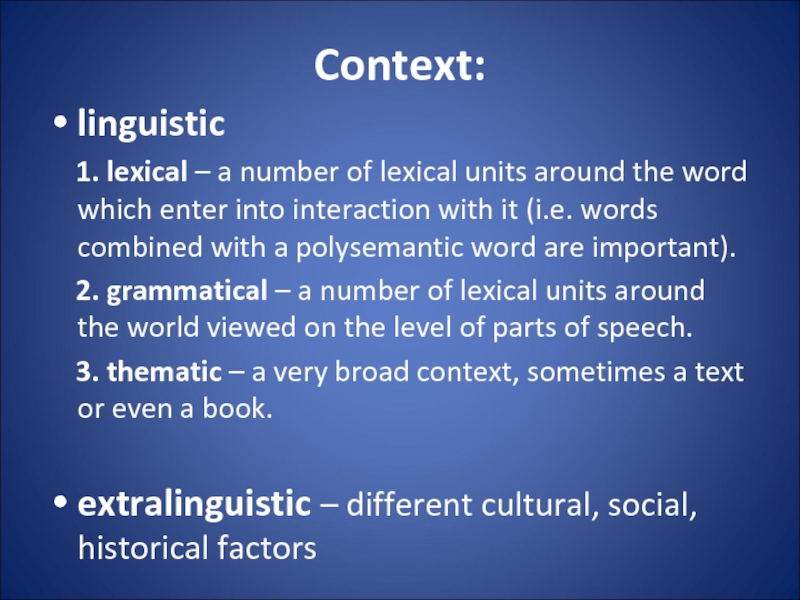
Слайд 58
4. Change of word-meaning: the causes, nature and results
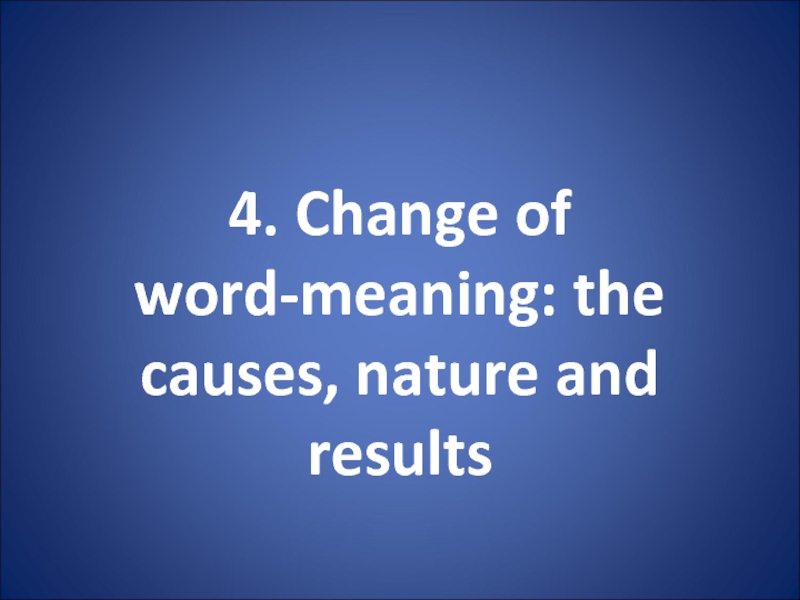
Слайд 59
The meaning of a word can change in a course
of time.
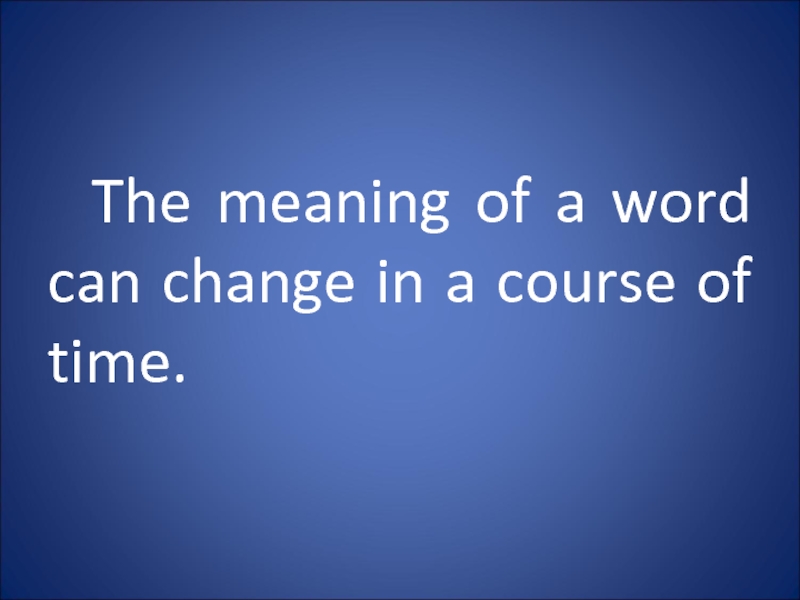
Слайд 60Causes of Change of
Word-meaning:
1. Extralinguistic (various changes in the life
of a speech community, in economic and social structure, in ideas, scientific concepts)
e.g. “car” meant ‘a four-wheeled wagon’; now – ‘a motor-car’, ‘a railway carriage’ (in the USA)
“paper” is not connected anymore with “papyrus” – the plant from which it formerly was made.
2. Linguistic (factors acting within the language system)
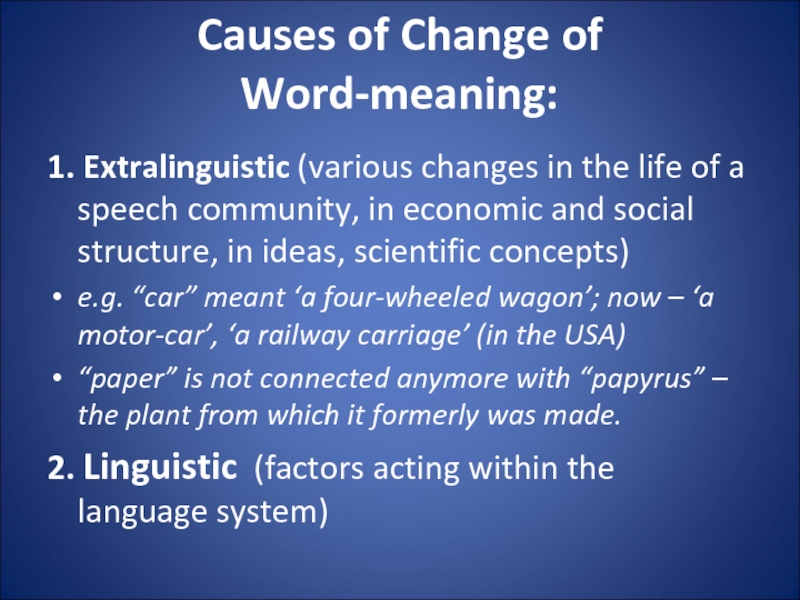
Слайд 61Linguistic Causes:
1. ellipsis – in a phrase made up of two
words one of these is omitted and its meaning is transferred to its partner.
e.g. “to starve” in O.E. = ‘to die’ + the word “hunger”. In the 16th c. “to starve” = ‘to die of hunger’.
e.g. daily = daily newspaper
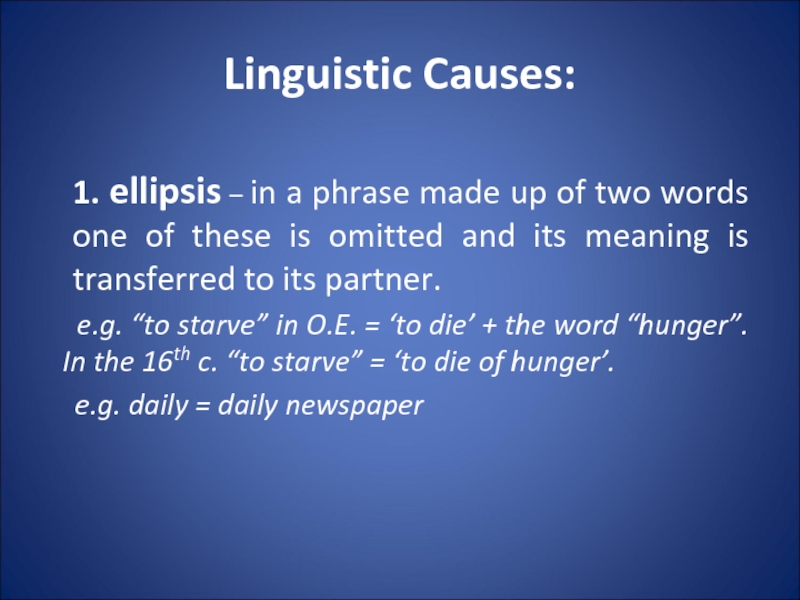
Слайд 62Linguistic Causes:
2. differentiation (discrimination) of synonyms – when a new
word is borrowed it may become a perfect synonym for the existing one. They have to be differentiated; otherwise one of them will die.
e.g. “land” in O.E. = both ‘solid part of earth’s surface’ and ‘the territory of the nation’. In the middle E. period the word “country” was borrowed as its synonym; ‘the territory of a nation’ came to be denoted mainly by “country”.
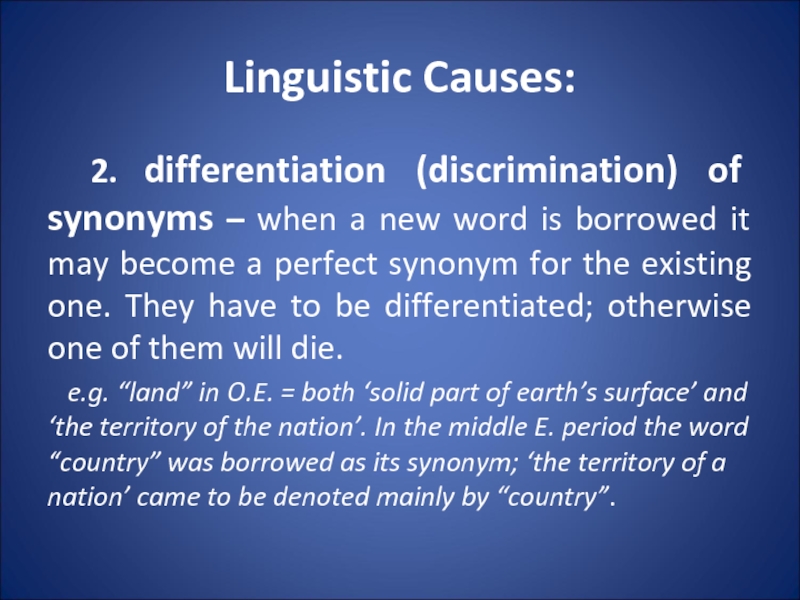
Слайд 63Linguistic Causes:
3. linguistic analogy – if one of the members of
the synonymic set acquires a new meaning, other members of this set change their meaning too.
e.g. “to catch” acquired the meaning ‘to understand’; its synonyms “to grasp” and “to get” acquired this meaning too.

Слайд 64
The nature of semantic changes is based on the
secondary application of the word form to name a different yet related concept.
Conditions to any semantic change: some connection between the old meaning and the new.
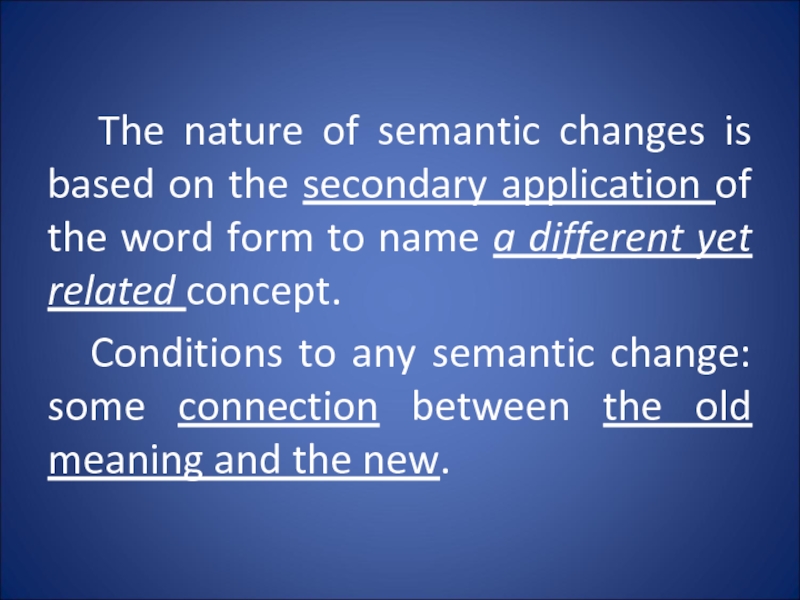
Слайд 65Association between Old Meaning and New:
similarity of meanings or metaphor –
a semantic process of associating two referents one of which in some way resembles the other
contiguity (closeness) of meanings or metonymy – a semantic process of associating two referents one of which makes part of the other or is closely connected with it
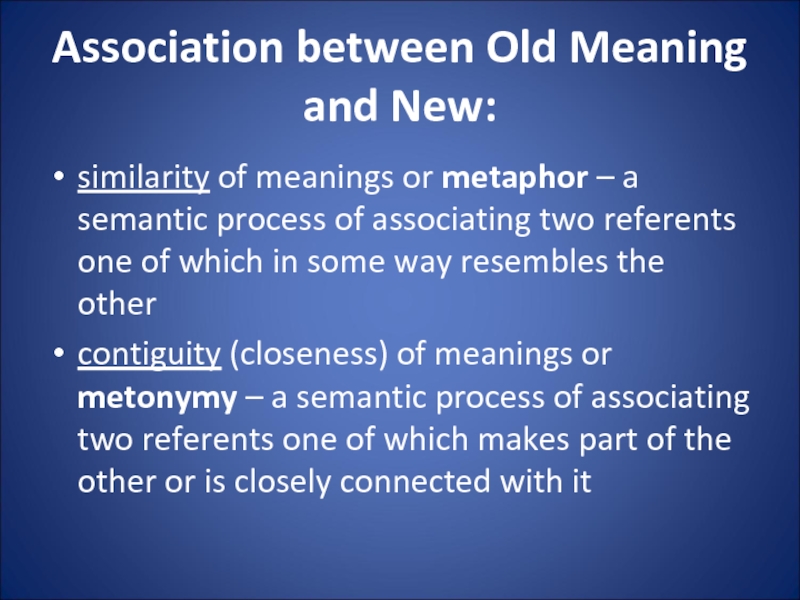
Слайд 66Types of Metaphor:
a) similarity of shape, e.g. head (of a cabbage),
bottleneck, teeth (of a saw, a comb);
b) similarity of position, e.g. foot (of a page, of a mountain), head (of a procession);
c) similarity of function, behavior, e.g. a bookworm (a person who is fond of books);
d) similarity of color, e.g. orange, hazel, chestnut.
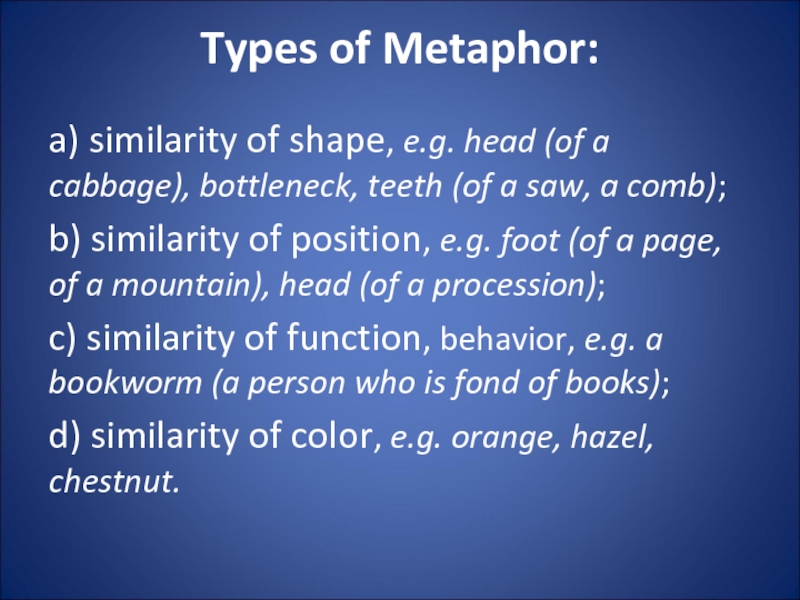
Слайд 67Types of Metonymy:
‘material — object of it’ (She is wearing a
fox);
‘container — containее’ (I ate three plates);
‘place — people’ (The city is asleep);
‘object — a unit of measure’ (This horse came one neck ahead);
‘producer — product’ (We bought a Picasso);
‘whole — part’ (We have 10 heads here);
‘count — mass’ (We ate rabbit)
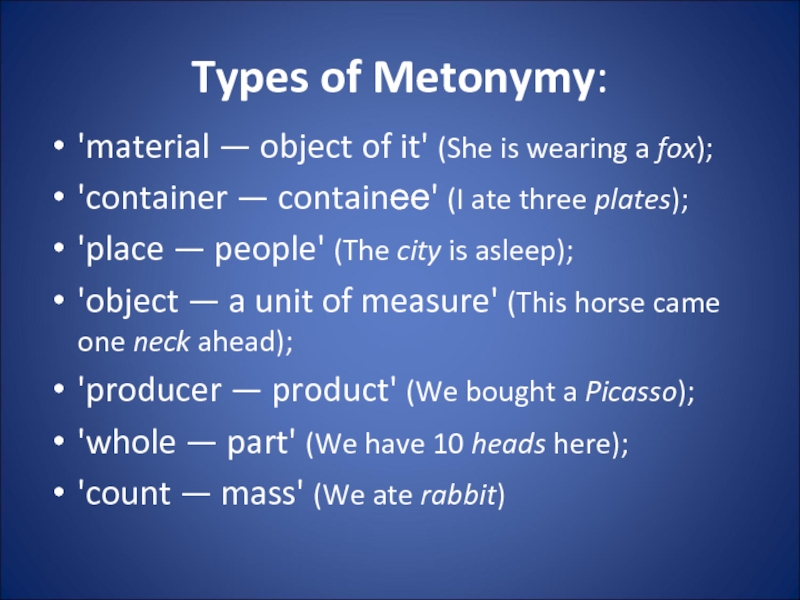
Слайд 68Results of Semantic Change:
changes in the denotational component
changes in the connotational
meaning
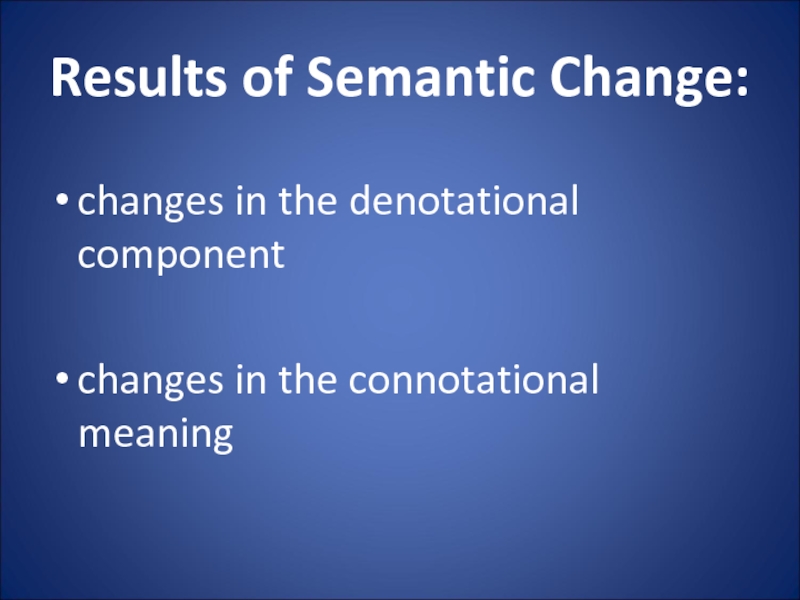
Слайд 69Changes in the Denotational Component:
restriction – a word denotes a restricted
number of referents.
e.g. “fowl” in O.E. = ‘any bird’, but now ‘a domestic hen or chicken’
extension – the application of the word to a wider variety of referents
e.g. ‘‘a cook’’ was not applied to women until the 16th century.
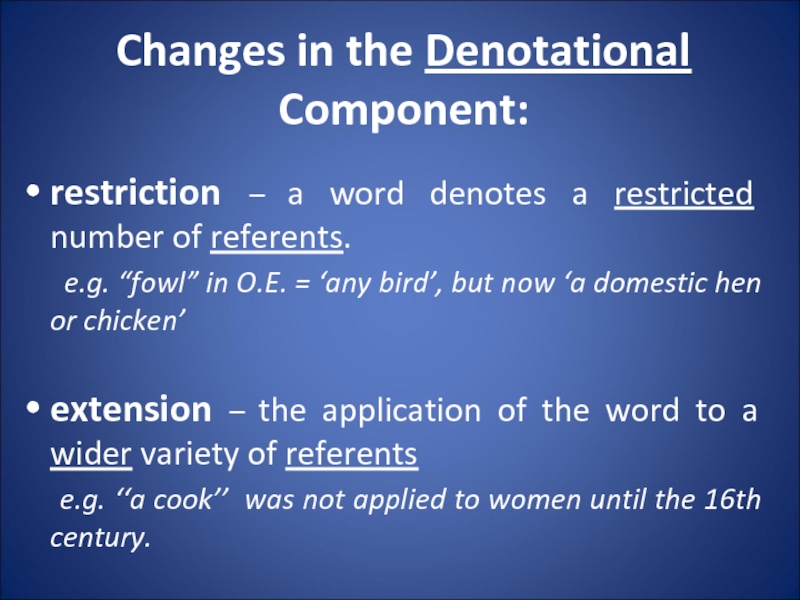
Слайд 70
generalization – the word with the extended meaning passes from the
specialized vocabulary into common use and the meaning becomes more general.
e.g. “camp” = ‘the place where troops are lodged in tents’; now – ‘temporary quarters’.
specialization – the word with the new meaning comes to be used in the specialized vocabulary of some limited group.
e.g. “to glide” = ‘to move gently and smoothly’ and now has acquired a special meaning – ‘to fly with no engine’.
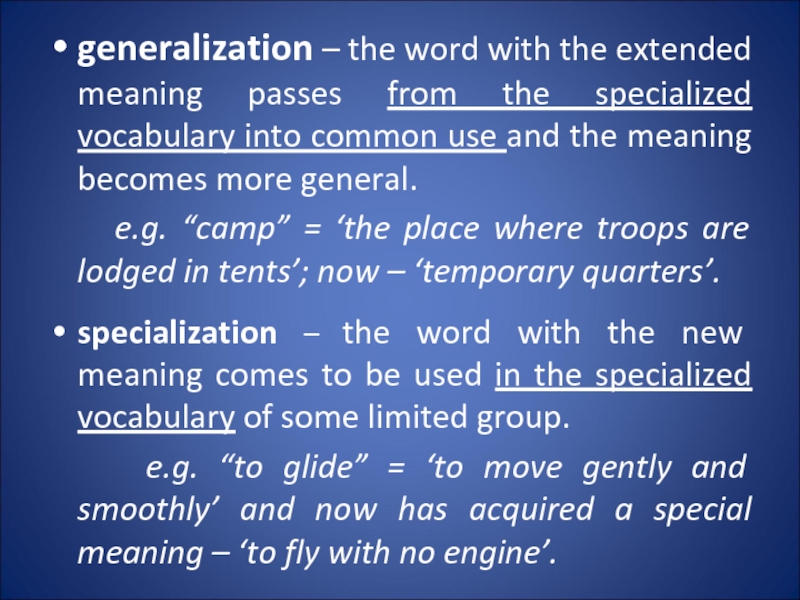
Слайд 71Changes in the Connotational Meaning:
pejorative development (degradation) – the acquisition by
the word of some derogatory emotive charge.
e.g. “accident” ‘a happening causing loss or injury’ came from more neutral ‘something that happened’;
ameliorative development (elevation) – the improvement of the connotational component of meaning.
e.g. “a minister” denoted a servant, now – ‘a civil servant of higher rank, a person administering a department of state’
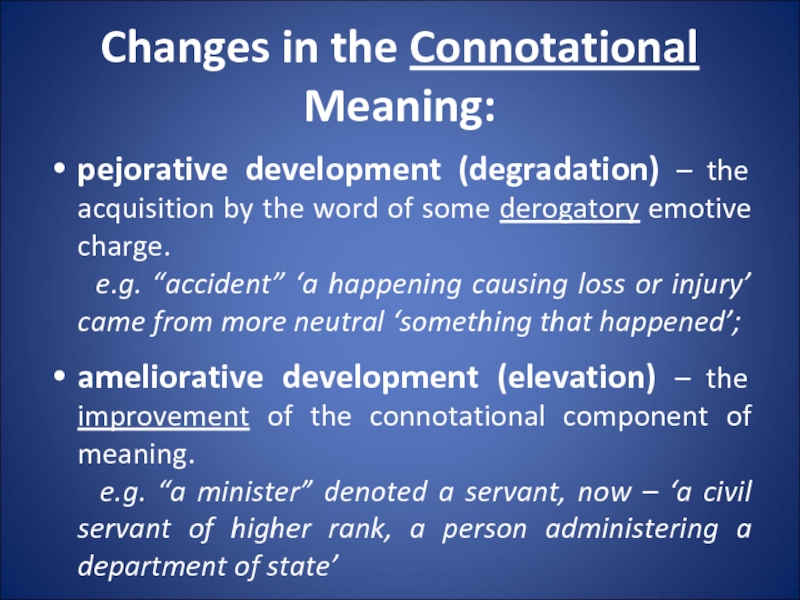
Слайд 72List of Literature:
Антрушина, Г. Б. Лексикология английского языка: учебник для студ.
пед. ин-тов по спец. № 2103 «Иностр. яз.» / Г. Б. Антрушина, О. В. Афанасьева, Н. Н. Морозова; под ред. Г. Б. Антрушиной. – М.: Высш. школа, 1985. – С. 129–142, 147–160.
Воробей, А. Н. Глоссарий лингвистических терминов / А. Н. Воробей, Е. Г. Карапетова. – Барановичи: УО «БарГУ», 2004. – 108 с.
Дубенец, Э. М. Современный английский язык. Лексикология: пособие для студ. гуманит. вузов / Э. М. Дубенец. – М. / СПб.: ГЛОССА / КАРО, 2004. – С. 74–82, 123–127.
Лексикология английского языка: учебник для ин-тов и фак-тов иностр. яз. / Р. З. Гинзбург [и др.]; под общ. ред. Р. З. Гинзбург. – 2-е изд., испр. и доп. – М.: Высш. школа, 1979. – С. 13–23, 28–39, 47–51.
Лещева, Л. М. Слова в английском языке. Курс лексикологии современного английского языка: учебник для студ. фак-в и отдел. английского языка (на англ. яз.) / Л. М. Лещева. – Минск: Академия управления при Президенте Республики Беларусь, 2001. – С. 36–56.
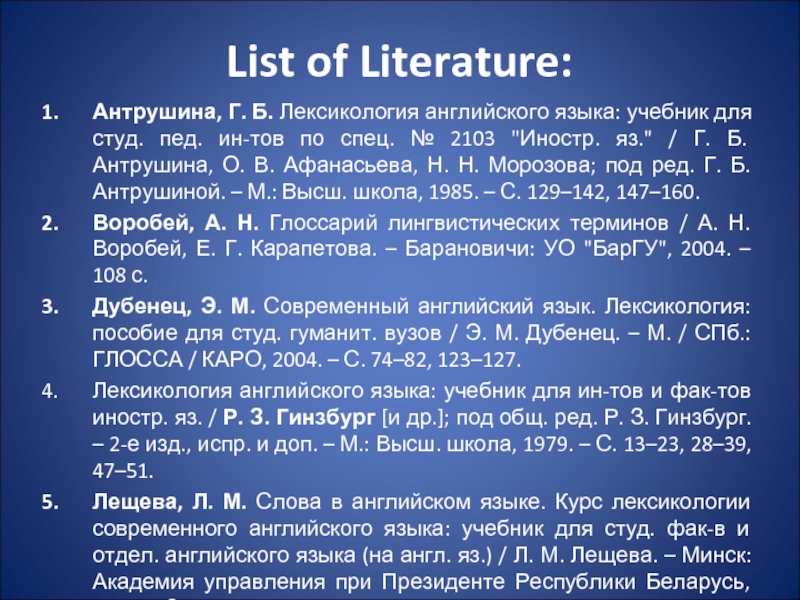
Слайды и текст этой презентации
Слайд 1
Слайд 2
Описание слайда:
Plan:
Semantics / semasiology. Different approaches to word-meaning.
Types of word-meaning.
Polysemy. Semantic structure of words. Meaning and context.
Change of word-meaning: the causes, nature and results.
Слайд 3
Описание слайда:
List of Terms:
semantics
referent
referential meaning
grammatical meaning
lexical meaning
denotational meaning
connotational meaning
polysemantic word
polysemy
lexical-semantic variants
basic meaning
peripheral meaning
primary meaning
secondary meaning
Слайд 4
Описание слайда:
It is meaning that makes language useful.
George A. Miller,
The science of word, 1991
Слайд 5
Описание слайда:
1. Semantics / semasiology. Different approaches to word-meaning
Слайд 6
Описание слайда:
The function of the word as a unit of communication is possible by its possessing a meaning.
Among the word’s various characteristics meaning is the most important.
Слайд 7
Описание слайда:
«The Meaning of Meaning» (1923) by C.K. Ogden and I.A. Richards – about 20 definitions of meaning
Слайд 8
Слайд 9
Описание слайда:
This linguistic study was pointed out in 1897 by M. Breal
Слайд 10
Описание слайда:
Semasiology is a synonym for ‘semantics’
(from Gk. semasia ‘meaning’ + logos ‘learning’)
Слайд 11
Описание слайда:
Different Approaches to Word Meaning:
ideational (or conceptual)
referential
functional
Слайд 12
Описание слайда:
The ideational theory can be considered the earliest theory of meaning.
It states that meaning originates in the mind in the form of ideas, and words are just symbols of them.
Слайд 13
Описание слайда:
A difficulty:
not clear why communication and understanding are possible if linguistic expressions stand for individual personal ideas.
Слайд 14
Описание слайда:
Meaning:
a concept with specific structure.
Слайд 15
Описание слайда:
Do people speaking different languages have different conceptual systems?
If people speaking different languages have the same conceptual systems why are identical concepts expressed by correlative words having different lexical meanings?
Слайд 16
Описание слайда:
finger ‘one of 10 movable parts of joints at the end of each human hand, or one of 8 such parts as opposed to the thumbs‘
and
палец ‘подвижная конечная часть кисти руки, стопы ноги или лапы животного’
Слайд 17
Описание слайда:
Referential theory is based on interdependence of things, their concepts and names.
Слайд 18
Описание слайда:
The complex relationships between referent (object denoted by the word), concept and word are traditionally represented by the following triangle:
Thought = concept
Symbol = word Referent = object
Слайд 19
Описание слайда:
an animal, with 4
legs and a tail, can bark and bite
dog
Слайд 20
Описание слайда:
Meaning concept
different words having different meanings may be used to express the same concept
Слайд 21
Описание слайда:
Concept of dying
die
pass away
kick the bucket
join the majority, etc
Слайд 22
Описание слайда:
Meaning symbol
In different languages:
a word with the same meaning have different sound forms (dog, собака)
words with the same sound forms have different meaning (лук, look)
Слайд 23
Описание слайда:
Meaning referent
to denote one and the same object we can give it different names
Слайд 24
Описание слайда:
A horse
in various contexts:
horse,
animal,
creature,
it, etc.
Слайд 25
Описание слайда:
Word meaning:
the interrelation of all three components of the semantic triangle: symbol, concept and referent, though meaning is not equivalent to any of them.
Слайд 26
Описание слайда:
Functionalists study word meaning by analysis of the way the word is used in certain contexts.
Слайд 27
Описание слайда:
The meaning of a word is its use in language.
Слайд 28
Описание слайда:
cloud and cloudy
have different meanings because in speech they function differently and occupy different positions in relation to other words.
Слайд 29
Описание слайда:
Meaning:
a component of the word through which a concept is communicated
Слайд 30
Описание слайда:
2. Types of word-meaning
Слайд 31
Описание слайда:
According to the conception of word meaning as a specific structure:
functional meaning: part of speech meaning (nouns usually denote «thingness», adjectives – qualities and states)
grammatical: found in identical sets of individual forms of different words (she goes/works/reads, etc.)
lexical: the component of meaning proper to the word as a linguistic unit highly individual and recurs in all the forms of a word (the meaning of the verb to work ‘to engage in physical or mental activity’ that is expressed in all its forms: works, work, worked, working, will work)
Слайд 32
Описание слайда:
Lexical Meaning:
denotational
connotational
Слайд 33
Описание слайда:
Denotational lexical meaning provides correct reference of a word to an individual object or a concept.
It makes communication possible and is explicitly revealed in the dictionary definition (chair ‘a seat for one person typically having four legs and a back’).
Слайд 34
Описание слайда:
to glare – to look
Слайд 35
Описание слайда:
Connotational lexical meaning is an emotional colouring of the word. Unlike denotational meaning, connotations are optional.
Слайд 36
Описание слайда:
Connotations:
Emotive charge may be inherent in word meaning (like in attractive, repulsive) or may be created by prefixes and suffixes (like in piggy, useful, useless).
It’s always objective because it doesn’t depend on a person’s perception.
Слайд 37
Описание слайда:
2. Stylistic reference refers the word to a certain style:
neutral words
colloquial
bookish, or literary words
Eg. father – dad – parent .
Слайд 38
Описание слайда:
3. Evaluative connotations express approval or disapproval (charming, disgusting).
4. Intensifying connotations are expressive and emphatic (magnificent, gorgeous)
Слайд 39
Описание слайда:
Denotative component
Lonely = alone, without company
To glare = to look
Слайд 40
Описание слайда:
3. Polysemy. Semantic structure of words. Meaning and context
Слайд 41
Описание слайда:
A polysemantic word is a word having more than one meaning.
Polysemy is the ability of words to have more than one meaning.
Слайд 42
Описание слайда:
Most English words are polysemantic.
A well-developed polysemy is a great advantage in a language.
Слайд 43
Описание слайда:
Monosemantic Words:
terms (synonym, bronchitis, molecule),
pronouns (this, my, both),
numerals, etc.
Слайд 44
Описание слайда:
The main causes of polysemy:
a large number of:
1) monosyllabic words;
2) words of long duration (that existed for centuries).
Слайд 45
Описание слайда:
The sources of polysemy:
1) the process of meaning change (meaning specialization: is used in more concrete spheres);
2) figurative language (metaphor and metonymy);
3) homonymy;
4) borrowing of meanings from other languages.
Слайд 46
Описание слайда:
blanket
a woolen covering used on beds,
a covering for keeping a house warm,
a covering of any kind (a blanket of snow),
covering in most cases (used attributively), e.g. we can say: a blanket insurance policy.
Слайд 47
Описание слайда:
Meanings of a polysemantic word are organized in a semantic structure
Слайд 48
Описание слайда:
Lexical-semantic variant
one of the meanings of a polysemantic word used in speech
Слайд 49
Описание слайда:
A Word’s Semantic Structure Is Studied:
Diachronically (in the process of its historical development): the historical development and change of meaning becomes central. Focus: the process of acquiring new meanings.
Synchronically (at a certain period of time): a co-existence of different meanings in the semantic structure of the word at a certain period of language development. Focus: value of each individual meaning and frequency of its occurrence.
Слайд 50
Описание слайда:
The meaning first registered in the language is called primary.
Other meanings are secondary, or derived, and are placed after the primary one.
Слайд 51
Описание слайда:
table
a piece of furniture (primary meaning)
the persons seated at the table
the food put on the table, meals
a thin flat piece of stone, metal, wood
slabs of stone
words cut into them or written on them
an orderly arrangement of facts
part of a machine-tool on which the work is put to be operated on
a level area, a plateau
Слайд 52
Описание слайда:
The meaning that first occurs to our mind, or is understood without a special context is called the basic or main meaning.
Other meanings are called peripheral or minor.
Слайд 53
Описание слайда:
Fire
1. flame (main meaning)
Слайд 54
Описание слайда:
Processes of the Semantic Development of a Word:
radiation (the primary meaning stands in the center and the secondary meanings proceed out of it like rays. Each secondary meaning can be traced to the primary meaning)
concatenation (secondary meanings of a word develop like a chain. It is difficult to trace some meanings to the primary one)
Слайд 55
Описание слайда:
crust
hard outer part of bread
hard part of anything (a pie, a cake)
harder layer over soft snow
a sullen gloomy person
Impudence
Слайд 56
Описание слайда:
Polysemy exists not in speech but in the language.
It’s easy to identify the main meaning of a separate word. Other meanings are revealed in context.
Слайд 57
Описание слайда:
Context:
linguistic
1. lexical – a number of lexical units around the word which enter into interaction with it (i.e. words combined with a polysemantic word are important).
2. grammatical – a number of lexical units around the world viewed on the level of parts of speech.
3. thematic – a very broad context, sometimes a text or even a book.
extralinguistic – different cultural, social, historical factors
Слайд 58
Описание слайда:
4. Change of word-meaning: the causes, nature and results
Слайд 59
Описание слайда:
The meaning of a word can change in a course of time.
Слайд 60
Описание слайда:
Causes of Change of
Word-meaning:
1. Extralinguistic (various changes in the life of a speech community, in economic and social structure, in ideas, scientific concepts)
e.g. “car” meant ‘a four-wheeled wagon’; now – ‘a motor-car’, ‘a railway carriage’ (in the USA)
“paper” is not connected anymore with “papyrus” – the plant from which it formerly was made.
2. Linguistic (factors acting within the language system)
Слайд 61
Описание слайда:
Linguistic Causes:
1. ellipsis – in a phrase made up of two words one of these is omitted and its meaning is transferred to its partner.
e.g. “to starve” in O.E. = ‘to die’ + the word “hunger”. In the 16th c. “to starve” = ‘to die of hunger’.
e.g. daily = daily newspaper
Слайд 62
Описание слайда:
Linguistic Causes:
2. differentiation (discrimination) of synonyms – when a new word is borrowed it may become a perfect synonym for the existing one. They have to be differentiated; otherwise one of them will die.
e.g. “land” in O.E. = both ‘solid part of earth’s surface’ and ‘the territory of the nation’. In the middle E. period the word “country” was borrowed as its synonym; ‘the territory of a nation’ came to be denoted mainly by “country”.
Слайд 63
Описание слайда:
Linguistic Causes:
3. linguistic analogy – if one of the members of the synonymic set acquires a new meaning, other members of this set change their meaning too.
e.g. “to catch” acquired the meaning ‘to understand’; its synonyms “to grasp” and “to get” acquired this meaning too.
Слайд 64
Описание слайда:
The nature of semantic changes is based on the secondary application of the word form to name a different yet related concept.
Conditions to any semantic change: some connection between the old meaning and the new.
Слайд 65
Описание слайда:
Association between Old Meaning and New:
similarity of meanings or metaphor – a semantic process of associating two referents one of which in some way resembles the other
contiguity (closeness) of meanings or metonymy – a semantic process of associating two referents one of which makes part of the other or is closely connected with it
Слайд 66
Описание слайда:
Types of Metaphor:
a) similarity of shape, e.g. head (of a cabbage), bottleneck, teeth (of a saw, a comb);
b) similarity of position, e.g. foot (of a page, of a mountain), head (of a procession);
c) similarity of function, behavior, e.g. a bookworm (a person who is fond of books);
d) similarity of color, e.g. orange, hazel, chestnut.
Слайд 67
Описание слайда:
Types of Metonymy:
‘material — object of it’ (She is wearing a fox);
‘container — containее’ (I ate three plates);
‘place — people’ (The city is asleep);
‘object — a unit of measure’ (This horse came one neck ahead);
‘producer — product’ (We bought a Picasso);
‘whole — part’ (We have 10 heads here);
‘count — mass’ (We ate rabbit)
Слайд 68
Описание слайда:
Results of Semantic Change:
changes in the denotational component
changes in the connotational meaning
Слайд 69
Описание слайда:
Changes in the Denotational Component:
restriction – a word denotes a restricted number of referents.
e.g. “fowl” in O.E. = ‘any bird’, but now ‘a domestic hen or chicken’
extension – the application of the word to a wider variety of referents
e.g. ‘‘a cook’’ was not applied to women until the 16th century.
Слайд 70
Описание слайда:
generalization – the word with the extended meaning passes from the specialized vocabulary into common use and the meaning becomes more general.
e.g. “camp” = ‘the place where troops are lodged in tents’; now – ‘temporary quarters’.
specialization – the word with the new meaning comes to be used in the specialized vocabulary of some limited group.
e.g. “to glide” = ‘to move gently and smoothly’ and now has acquired a special meaning – ‘to fly with no engine’.
Слайд 71
Описание слайда:
Changes in the Connotational Meaning:
pejorative development (degradation) – the acquisition by the word of some derogatory emotive charge.
e.g. “accident” ‘a happening causing loss or injury’ came from more neutral ‘something that happened’;
ameliorative development (elevation) – the improvement of the connotational component of meaning.
e.g. “a minister” denoted a servant, now – ‘a civil servant of higher rank, a person administering a department of state’
Слайд 72
Описание слайда:
List of Literature:
Антрушина, Г. Б. Лексикология английского языка: учебник для студ. пед. ин-тов по спец. № 2103 «Иностр. яз.» / Г. Б. Антрушина, О. В. Афанасьева, Н. Н. Морозова; под ред. Г. Б. Антрушиной. – М.: Высш. школа, 1985. – С. 129–142, 147–160.
Воробей, А. Н. Глоссарий лингвистических терминов / А. Н. Воробей, Е. Г. Карапетова. – Барановичи: УО «БарГУ», 2004. – 108 с.
Дубенец, Э. М. Современный английский язык. Лексикология: пособие для студ. гуманит. вузов / Э. М. Дубенец. – М. / СПб.: ГЛОССА / КАРО, 2004. – С. 74–82, 123–127.
Лексикология английского языка: учебник для ин-тов и фак-тов иностр. яз. / Р. З. Гинзбург [и др.]; под общ. ред. Р. З. Гинзбург. – 2-е изд., испр. и доп. – М.: Высш. школа, 1979. – С. 13–23, 28–39, 47–51.
Лещева, Л. М. Слова в английском языке. Курс лексикологии современного английского языка: учебник для студ. фак-в и отдел. английского языка (на англ. яз.) / Л. М. Лещева. – Минск: Академия управления при Президенте Республики Беларусь, 2001. – С. 36–56.








































































![List of Literature:
Антрушина, Г. Б. Лексикология английского языка: учебник для студ. пед. ин-тов по спец. № 2103 "Иностр. яз." / Г. Б. Антрушина, О. В. Афанасьева, Н. Н. Морозова; под ред. Г. Б. Антрушиной. – М.: Высш. школа, 1985. – С. 129–142, 147–160.
Воробей, А. Н. Глоссарий лингвистических терминов / А. Н. Воробей, Е. Г. Карапетова. – Барановичи: УО "БарГУ", 2004. – 108 с.
Дубенец, Э. М. Современный английский язык. Лексикология: пособие для студ. гуманит. вузов / Э. М. Дубенец. – М. / СПб.: ГЛОССА / КАРО, 2004. – С. 74–82, 123–127.
Лексикология английского языка: учебник для ин-тов и фак-тов иностр. яз. / Р. З. Гинзбург [и др.]; под общ. ред. Р. З. Гинзбург. – 2-е изд., испр. и доп. – М.: Высш. школа, 1979. – С. 13–23, 28–39, 47–51.
Лещева, Л. М. Слова в английском языке. Курс лексикологии современного английского языка: учебник для студ. фак-в и отдел. английского языка (на англ. яз.) / Л. М. Лещева. – Минск: Академия управления при Президенте Республики Беларусь, 2001. – С. 36–56.](https://myslide.ru/documents_3/42a164a5a4e7b28700c7e7daf5bc5db6/img71.jpg)